#this also functions as a reference sheet of sorts
Explore tagged Tumblr posts
Text

redraw!
#self ship#self shipping#self ship community#self insert#tintin#my art#this also functions as a reference sheet of sorts#🩵✈️
130 notes
·
View notes
Text
hrghhhh how would you even go about mending an felt and fabricked and metal based animatronic
#disco speaks!#I’m trying to use references cause like they wouldn’t be restored#but they would be cleaned up and repaired/replaced in some way??#like I’m thinking about springtrap btw#like maybe use rubber or a plastic shell (plastic would be prone to breaking) rubber might be too toxic to the actual decayed muscle#and general mummified tight skin/muscle underneath so maybe a silicone based sheet layer?#yeah silicone would make the most sense for that layer#and then having like sort of fire house material or hrmm like neoprene or Kevlar lining on top of that#for general protection#is the casing fully fused to him??#how the fuck does that work#cause with the other animatronics you are just welp child body decays in their and their soul is trapped#so eventually the body is decomposed and essentially no use to the interior and motor functions of the suit#however in springtrap’s case that is not the same#while it can perform on its own it’s meant to have a wearer in it to puppet the movements#so when his body dies does it fuse to just the endo inside??#BUT THERE IS NO ENDO INSIDE??#yeah cause wait#he is the endo of the suit#(skeleton inside a skeleton (skeletonception if you will))#there is supposedly bracing for the spring locks and the interior structure of the suit#I’m still baffled on how it would’ve stood up on its own ngl#I’ve made a puppet head with a metal strap to create the base and then used fabric and foam as a covering#but also that would abrasive I like the idea of the jumpsuit like the movie version has but again material would have been corroded by blood#and other organic fluids as a result of decomposition#like the stomach would have had leaking bile and so would most of the organs due to the punctures#and there is also bladder which becomes loose due to lack of muscle strength so those fluids would take effect#and then the jumpsuit would chafe skin and cause infection as well#well not really infection once deceased but like it wouldn’t help
5 notes
·
View notes
Text
Dia's FFXIV Art Reference Notes, A possibly long post
Hello! I made this as a thread on my twitter but I might as well post a version of it here. For the record this will be a thread linking to the resources I use when drawing commissions or fanart, I have not made Any of these and whenever I can I will note the creators and link directly to their resources.
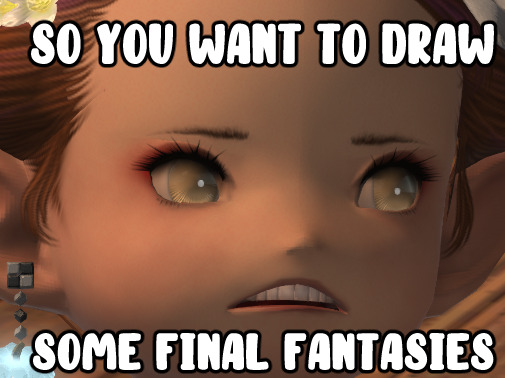
GPose Reference First and foremost, if you're drawing a WOL or ordering a commission of your WOL the most important thing is to take a proper reference GPOSE. I use the method in this post, to make sure I got all the angles. Clean refs are super important when drawing armor/intricate outfits so take care to take simple standing poses like the one in the tweet above. Cool dynamic poses might be fun but they're not really useful for referencing.
Gear/Weapon Reference
If you need good references for a weapon/outfit that you don't have a GPOSE for, I recommend using the attire website
This is a japanese website maintained by @/chiyo_asa on twitter and if you've ever looked up a piece of gear in the lodestone you've almost definitely come across their pictures.
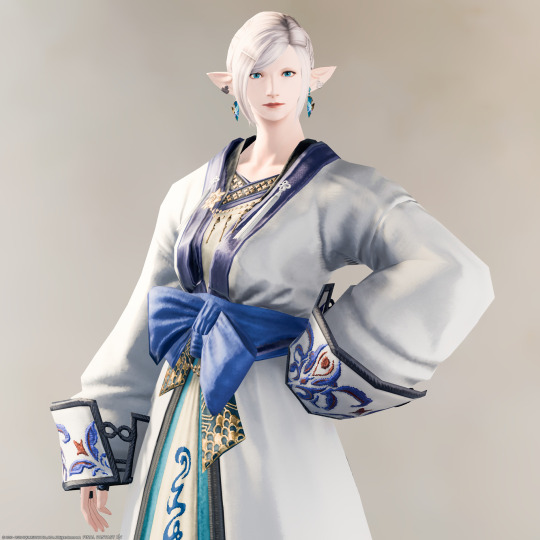
This is a super rough translation in english of the menu of the website. While it is in Japanese it's very easy to navigate and all the pictures in the site are super high quality and very useful for referencing.
This is my number one source for gear references I haven't taken myself

The "mirapuri" button afaik is for glams they made themselves that they want to showcase.
An important note about this site specifically is that I believe it's currently undergoing an overhaul so Some weapons/gearsets might not be completely transferred in yet.
That being said, the majority of sets from dungeons/crafting/alliance raids/job gear sets etc are sorted like so, which makes it super easy to look for.
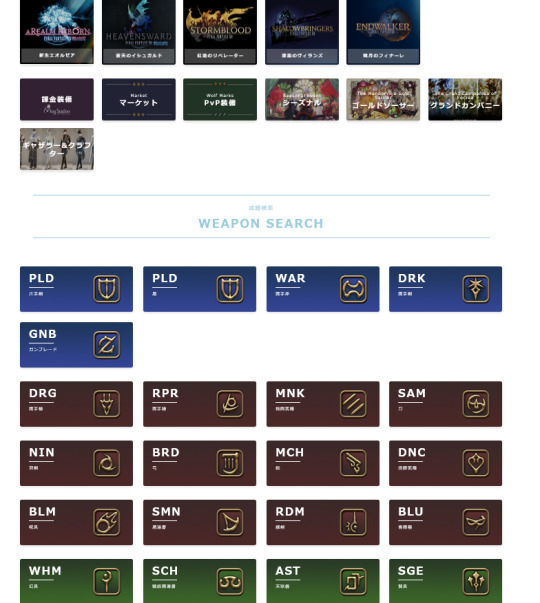
There IS also a search function but I'm pretty sure it works only for japanese input.
NPC reference sheets
@xivrefsheets Offers really detailed resources of npc models. They also occasionally accept requests on their ko-fi (closed at the time of writing this)
These are super useful and really high quality, especially for some of the boss refs they've done. As someone who doesn't use anamnesis I go back to their refs very often
Convocation of the Fourteen refs
Maintained by @/Igeyorhm on twitter this site has a nice list of Ascian refs per character in addition to some lore bits for each of them. Also some very useful closeups of the Ascian clothes.
Even more NPC and Boss Refs
I believe maintained by @/MlNRATHOUS on twitter, this site has a really nice array of major NPC and boss references in various angles and with colourpicks for skintone and hair which is super useful. I use them a Lot
Lalafell centric refs
Norirow Note is a super cute blog that showcases glam items/ weapons/ chocobo barding and more.
It is NOT meant to be an art reference, however if you play a lala like me, I find their showcases useful when drawing gear on lalas.
Even if you don't use it as an art ref it's a super cute blog that's just fun to go through AND fully translated in english so I recommend just having a fun time reading through it anyway.
Bonus- Au Ra Scales.
I literally found out about this today but @/saficchi on twitter has made a super detailed angled ref sheet for both male and female au ra scales and I love them for it
Bonus 2 electric boogaloo- TextTools
I use this to import 3d models of specific weapons into CSP if I'm drawing them.
I don't know how useful this is for other art software but it's saved my ass from freehanding titania weapons so in the thread it goes

That's the full list of refs I personally use, if there's more that people want to add please feel free to do so in the comments. I hope it helps people out in their creative endeavors!
#ffxiv#final fantasy xiv#ff14#final fantasy 14#reference#references#ffxiv reference#art reference#dia rambles
158 notes
·
View notes
Text
and if I get burned, at least we were electrified by @seiya-starsniper
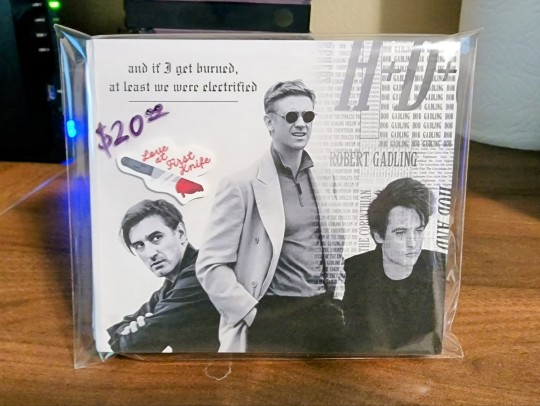
The latest bind here at Mountain Press Publishing! This one was a ton of fun and made for a chuck of firsts for me as well! From making a book of a smaller size (and a different size than my usual in general!) to refreshing my Illustrator knowledge as well as some quick sticker making, this ended up being a very fun project!
Initially, I planned for this bind to be the size of a CD album (and it was), but I intended to be able to fit it within a CD case itself. However, it ended up being the perfect size of a case, which meant it didn't actually fit inside of the case.
Lessons learned there!
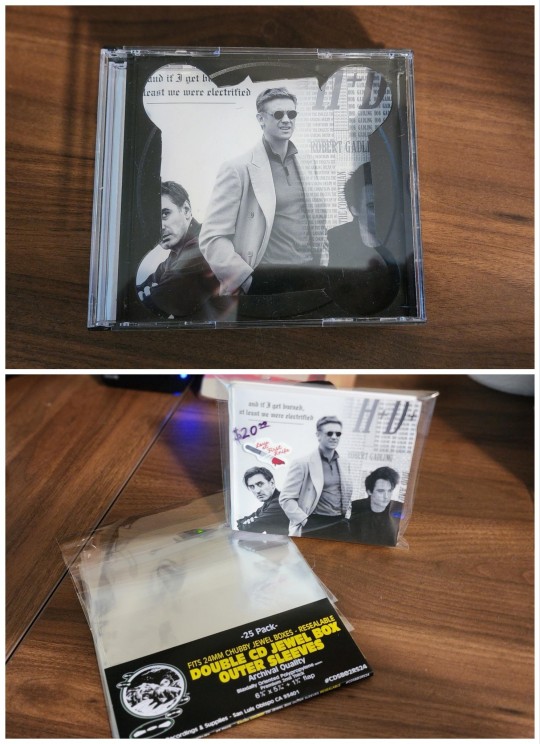
Thankfully, I had also picked up some CD case sleeves that I was able to package the book within to still achieve that aestethic I was going for.
Now, you may be wondering why I went for a CD size at all. This fic's title (as well as Chapter Titles) were all based on lyrics from Taylor Swift's reputation album! Which, once I found that out, helped me solidify the styling I was going for.
I looked up the Reputation album and the styling and fonts that were used on the cover images as well as the lyric booklet within, which is how I settled on the drop caps and the fonts I choose.

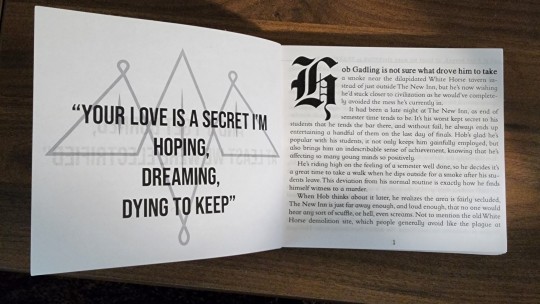
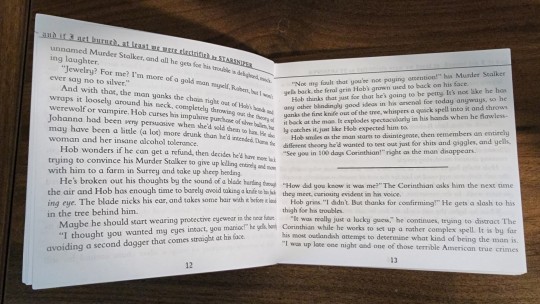
And here's the reference image I used for the text
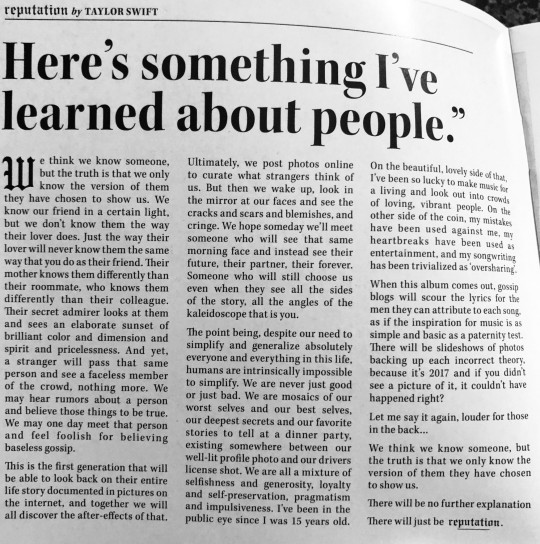
You can see that the fonts are pretty similar. The header in the book also matches the header here!
And, of course, if I was diving down this copy of Reputation, I had to make a matching cover as well!
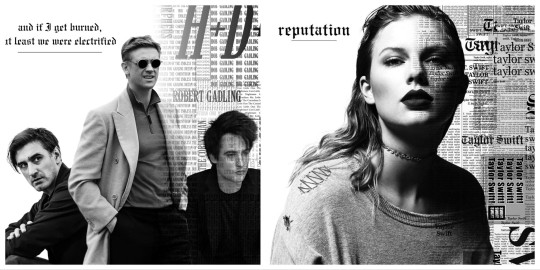
Shout out to the Sadman server's channels devoted to Ferdie and Tom and Boyd. I had plenty of good photos to sift through and choose from to get all the boys in the image!
Here's a full view of the cover, spine, and back as well. And yes, I did have to pen tool that summoning circle by hand since I couldn't find a good transparent one online!
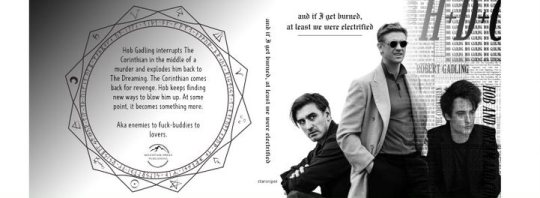
Now, for the chapter headers, you may have noticed some peculiar images in the back. In the fic, The Corinthian as well as Dream have symbols, signatures of sorts, that they have. Old ones, made before humanity as we know it. They end up featuring a few times, mainly when the marks appear on Hob, marking him as theirs. So, of course, I had to design those as well!

The Corinthian's is on the left and sharper than Dream's, which I thought fitting for a nightmare. There's the theme of three in his, with the three sections, three lines, and three little swoops. The design is also mirrored, which ties nicely to his function as humanity's dark mirror.
For Dream, his is more fluid, more swoopy. It starts like a circle that quickly breaks into diverging lines, similar to the unreality of dreams and their meandering paths. It also looks somewhat like a treble clef, which also ties well with Dream's role and relations to the arts and creative pursuits.
The final image is of their marks combined, swooping and curling around one another.
The last major part of this bind was the stickers that I created and printed to go along side the book! Since the CD case didn't work out as I had hoped, I still wanted to add something special and unique to this gift for Seiya, so I decided to design some sticker that went along with the fic! I didn't take photos of them all cut out, unfortunately, but I do have the original sheet here.
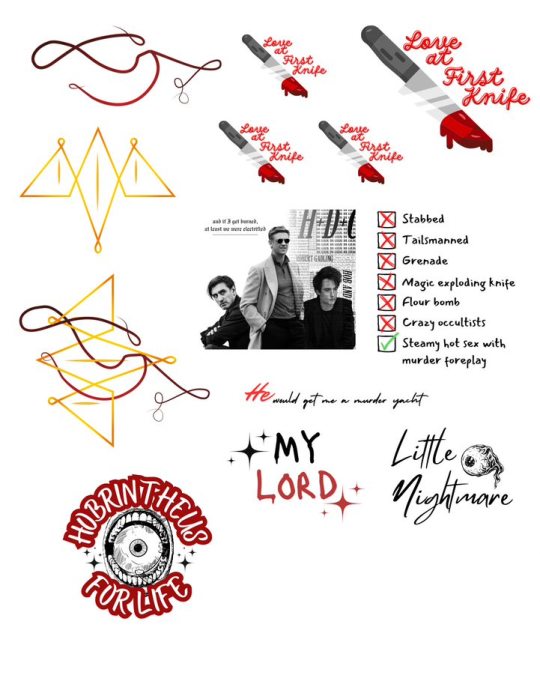
We have the marks in color, the album cover, along with some more fic specific stickers! These were really fun to design, honestly. I have the knife one on my laptop currently! 😂
Overall, this was an amazing fic and if you're a Hobrintheus or Hobrinthian lover, you definitely need to check it out! This project was a ton of fun to work on and I'm so glad I could get a copy to the wonderful author ♥️
82 notes
·
View notes
Note
Do you have any recommendations for art references and or video's that might help me improve as an artist? Your art style is really inspiring to me and I'd love to get better at drawing because I haven't been on that grind recently of doing so!!!
Honestly your best bet is learning the RULES of art instead of the process, at least that's how I did it
I find it easier to NOT do the things that make it wrong than to learn ALL the things that make it good
There's like a million different ways to make art appealing but a lot of them typically avoid the same mistakes. It also makes the learning process customizable for you
To anyone else other than Gongus, I wanna say first that this post is heavily catered to cartoonier art styles but the links are for general art. I will also be laying down a lot of the things I learned from college (multimedia arts course)
Alright, first of all try to dabble up on some character design rules, here's a video that teaches it and a channel that has a series with critiquing people's portfolios
youtube
(she's not really insulting the portfolios btw, the thumbnails are just click baity)
Then also learn about the 12 animation principles because it can still be applied to non animation art like comics and stuff
youtube
Get yourself some line of action crammed in there. Regardless of art style, a lot of people struggle with stiffness, line of action is the counter attack to it
youtube
Optionally, if you're gonna learn line of action then you're gonna be doing gesture drawings to practice it. I suggest going to @adorkastock for reference images
Next up, color also have rules so here's the basics
youtube
I only linked that so you can smoothly transition here wjsndndm
But YEAH color fuckery is an underrated art cheat, you can get away with art that looks good without shading if you know how to toy with the colors right
youtube
Trouble making thumbnails?
Photography as an art form has got your back. Composition techniques can be applied to the drawing sort of art
youtube
Here are my personal tips now skskksks
1. Use your inspirations as reference. I got a sense of solidity when I saw the reference sheets for Wander Over Yonder and copying stylistic aspects from DST, TF2 comics, Clone High, and Pizza Tower.
SPEAKING OF TF2, I also wanna throw in this video about it's character design and other visual aspects (you'd only wanna watch the first half, the rest talks about the characters writingwise)
youtube
2. Another thing I do with references to make it easier is draw it at least two times. First time to trace it (directly or eyeballing it. You can also do with skeleton sketch or not but preferably give it a skeleton), then the second or third or fourth is to make it slowly morph into your style.
This will give you a sense of solidity, teaching your hand the traits that should be kept or exaggerated
3. If it looks like ass or you don't like it then that's okay. You DON'T have to post EVERYTHING you make. Sometimes you will feel like you draw a character you've always drawn wonky and that's because you just need to do warm up doodles.
I have SO MUCH sketches that I haven't posted and will never post because they're warm ups. Y'all think Pepperman is hard to draw? Y'all think I draw him good? I have good news for you, I fumble his face more often than not AND THATS OKAY
4. ANOTHER niche technique is to learn the keyboard shortcuts and other functions of your art program. Do not underestimate how much time that can spare you. It's gonna be tricky to find or get used to but it's gonna be so worth it
I learned you can alt+G on Krita one day and it makes a folder for your layers, total game changer. I can move layers at once instead of the old one by one with precision
5. Final note is to do the opposite of everything Vivsiepop does, it does not matter if you like her shows or not because time and time again critiques of her art and writing style breaks SO MANY RULES without UNDERSTANDING why they exist in the first place.
Art is like architecture, you need to know how to make a basic house before going straight for the fucking manor from Hello Neighbor 💥 or else you're never gonna figure out why the living room collapses everytime you flush the toilet
Anyway eeee, that's about everything I can teach, hope these help and if there's anything else to ask or add on, please do so!
23 notes
·
View notes
Text
the world (it burns through me)
Chapter 9: Freelancer
Ao3 | 5.8k Words | Freelancer’s POV
Freelancer’s last three Thanksgivings. Sunshine comes back to life. Caelum is traumatized. Gavin is no longer a prostitute. Darlin’ is also traumatized.
TW: discussions of child abuse, disordered eating habits, and sexual assault.
It was the week before your first Thanksgiving in medical school and you were standing in the morgue at Dahlia General hospital and watching a tall, handsome doctor cut into a corpse like it was an act of love. Dr. Brachium was a looker to put it mildly. You weren’t small by any means, but he hit six feet with ease. His lithe frame fell in his scrubs and drapings like his body was built specifically for medical gear to smother it. His hair was jet black and long enough he had to pin it back in a braid under his scrub cap. He was working with cadavers, not living patients, so he didn’t have to wear a mask. You preferred that, because it let you get a good look at his full lips as they quirked through soft smiles, crinkling his mono-lidded eyes handsomely as he explained how to remove and weigh the major organs as one performed an autopsy.
This was the process, your instructors insisted. You started with theoretics, diagrams, textbooks, that sort of thing. Then, you moved on to other mammals. You dissected pigs and cats, noted that the variety that the living body was capable of made your diagrams and textbooks functionally useless for anything besides casual reference. You watched videos of surgery, practiced stitches on fruit and pig skin. Then, you watched autopsies. You watched handsome doctors like Brachium cut open mothers and brothers and daughters and struggled to find the energy to remember the person that used to inhabit the cadaver under your careful scrutiny.
Dr. Brachium spoke quietly, as though afraid to wake up the smattering of corpses laid out on tables in his pristine, freezing morgue. Eight odd students gathered around his table, just the dedicated bunch that had signed up for his late night lab slot instead of going home to their fucking families for the holidays. This was more important than a family dinner, you insisted to yourself, and your mother was far more satisfied with your performance at school than she would be with your lackluster stuffing. So, despite Lasko’s insistence that students in rigorous courses like yours did much better when they took adequate breaks, you were staying in Dahlia for your week off. He was a good advisor, and he understood a lot, but he didn’t understand this. He couldn’t.
“That’s the last of it.” Dr. Brachium held his cadaver’s heart in his hands, still and blue. “If you look here, we can see that Mr. Swanson did indeed die of heart failure. See the pericardial fat surrounding his arteries? It was unfortunately only a matter of time. He would have been in considerable chest pain for a few weeks proceeding the cardiac arrest that eventually killed him. Should any of you become internal medicine doctors, please emphasize that your patients should always take chest pains seriously.”
He placed the heart in the shining, metal scale, read the weight aloud for his record and carefully placed each organ inside a plastic biowaste bag, then the bag back inside the now empty body cavity.
“If you’re on the surgical path, you’d be doing a lot of this. When you’re working with live patients, you’ll take the time to carefully arrange the organs. The body knows where they should go and will make any minor adjustments that need to be made, but the healing process can be hindered if you just… throw things in there.” He crinkled up his nose like it was a cute joke. You couldn’t help the smile that snuck onto your lips.
The swinging double doors to the morgue opened as two doctors in white coats and light green scrubs pushed in a gurney. The small frame strapped down on it was covered in a white sheet, the kind that was meant to be waterproof but held on to blood anyway. It was dotted with red like a Halloween decoration.
The interns ignored the eight of you and instead turned to Dr. Brachium, handing him a chart as they stripped down the trauma gloves they had been wearing. This one must have been fresh out of the trauma bay. Finally, something more interesting than a morbid heart disease. You might actually get to practice some trauma medicine before they put this one on ice.
Brachium thanked the interns by name, something that made you feel strangely fond, and sent them back up to the emergency room. He read the chart carefully, shaking his head, a pinch of pity between his full brows.
“That’s a shame.” He tutted. “A car accident. And so young…” he looked genuinely grieved as he handed the chart to the student closest to him, another surgical hopeful named Kody you’d had a few classes with. Kody read the chart ravenously, his eyes wide, his face breaking out into a grin. You didn’t know how Dr. Brachium managed to grieve over every body in his morgue, but your stomach flipped when you realized you felt closer to Kody’s blind giddiness at the body’s learning potential. The two of you had a similar hunger.
Brachium pulled the sheet back, revealing a charming baby face and styled pixie cut, hair meant to stick up in this place and that very intentionally. Instead, carved bangs were matted to the corpse’s forehead with dried, blackened blood. There was a large cut across their forehead, and when you leaned in closer to get a better look, you realized it was actually a skull fracture. You starred for so long you thought you could see their pinkish, shivering brain matter.
That was impossible, of course. Once the brain stopped functioning it changed color, from healthy pink and gray to blueish-green. You were seeing things.
Brachium cut away their torn clothes, revealing a sizable laceration in their stomach. He prodded around it with his gloved hands, noting the organ damage and oozing, dark blood that sprouted from the cuts in their liver.
“This was a catastrophic crash.” Brachium shook his head. One hand landed on the corpse’s head stroking the stray hair out of their closed eyes. “Oh, little one. We don’t even know your name.”
“How does that work?” You asked. That wasn’t actually going to be part of your job, identifying corpses, but you felt compelled to ask anyway. You felt suddenly self conscious as Brachium’s attention shifted to you. “Like… how do we figure it out? When there’s a body with no ID, I mean.”
“There are a few ways.” Brachium nodded. He considered you for a moment before his face softened and he continued. “The police are likely still clearing the scene, and since they were driving, there is most probably a driver’s license somewhere in the vehicle. This laceration-” he waved his hand over the cut, “-was caused by the driver’s side door of the car. Look here, at the particles left in the skin.” You leaned in close, your face inches from their still-warm body.
“Their car was blue.” You found yourself murmuring. Brachium nodded.
“They would have had to be cut out. The car is a mess, so it might take a while to find everything we need from it. If that fails, then we move on to fingerprints, then dental records. Most people are identifiable. Most people have people who are looking for them. It is very rare for bodies to go unclaimed.”
“Can we…” Kody gestured towards the corpse, seeming impatient with his arms crossed. Brachium broke his concentration on you and turned towards your classmate.
“The dead are in no rush, friend.” He said softly. “We have time for any questions anybody has.”
Your mouth clicked shut and you leaned back, embarrassment burning across your cheeks. Brachium watched, his face closing off, as you pulled away.
You watched intently, silently, as Dr. Brachium prepared the body for the autopsy. He straightened out the gangly limbs, arranged its broken form into something resembling order, and muttered quietly as he brushed dried blood and debris from its face. Kody stepped up to stand next to you, and everytime Brachium made a soft comment, called the corpse a sweet name, said something as though to comfort it, Kody snickered softly, under his breath, where only the two of you could hear.
You watched, your eyes on their oozing wounds, waiting for the blood flow to stop. Eventually, the pressure in the chest cavity would let up and the blood would stop. Eventually…
You moved back around the table, towards the head. You bent at your middle, crinkling the trauma gown that had been draped over your street clothes. Your sneakers squeaked over the tile floor. You bent down and inspected the skull fracture again. By this time, the brain should have gone necrotic. You wanted to see it for yourself.
The exposed section of their brain shone up at you under the bright, morgue lights, still pink, still twitching.
“Wait!” You cried, as Brachium raised his scalpel to cut into their chest. Every pair of eyes in the room snapped to you. You froze suddenly under the attention, your body going cold. If you were wrong, this was going to be so fucking embarrassing. If you were right, though…
“What is it?” Brachium set his scalpel down and circled the table to stand next to you. You raised a shaking, gloved finger to the skull fracture.
“Their brain…” you breathed, afraid that if you broke the silence that had fallen over the room, whatever life was left in them would slip away. Brachium gasped, bent closer, and then reared back. He reached blindly for the controls under the table and lowered it quickly.
“Compressions.” He told you sternly as he stripped his gloves off and reached for two new pairs. “You-” he waved to one of your classmates, Elena, you thought, “-that big button on the wall, press it. And you-” he pointed to Kody as he slipped his new gloves on, “-just outside the door there’s a crash cart. Bring it in now.”
“What’s happening?” Another classmate called from the back of the group.
“They’re alive.” Brachium said. The morgue descended into chaos.
It took fifteen minutes for more doctors to arrive, even as the Code Blue blared around the echoing space. Whoever was in charge of the alarm system turned it off at one point. Brachium had looked up, panic flashing over his eyes and ordered Elena to hit the alarm again.
You knew how to give chest compressions. You’d been certified since you were in high school, when you’d taken every medical-adjacent course your school had to offer. It felt different on a body than it had on the dummy they gave you to practice on. You felt the corpse’s- the patient’s- ribs crack and give under your relentless movements. You watched out of the corner of your eye as Dr. Brachium intubated, slid a tude down their throat. Their hand, which had laid limp and lifeless on the slab a few minutes before, trailed up to grab at his wrist. He took it in his own and held it as he pumped the blue AMBU bag, breathing for them, in the other.
“How does this happen?” Kody asked after retrieving the crash cart. He attached the sensors to the portable heart monitor around your hands. “Aren’t they supposed to check things like this before they even get to the ER?”
“Yes.” Brachium muttered, still whispering sweet encouragement to the patient as he worked. “They are.”
Eventually, interns arrived, walking casually, seeming to think that this was a false alarm. You couldn’t imagine that the morgue called codes all that often, so you could hardly blame them for assuming it was an accident. As soon as they saw you and your shaking, spent arms pounding into your patient, they sprung into action.
“Why didn’t they receive a head CT?” Brachium snapped, his voice turning sour and harsh for the first time since you’d met him a few hours ago. The two interns that had brought your patient down in the first place went pale and shared an alarmed look.
“The paramedics said-” one started, but Dr. Brachium cut them off as somebody took over the AMBU bag for him. Somebody else pushed you out of the way and continued your compressions with renewed force. You stumbled back, a hand wrapping around your back to support you. When you looked up, Kody smiled softly and waited for you to catch your footing.
“I don’t care what the paramedics say!” Brachium snapped. “When you receive a patient in the ER, you run the necessary checks before bringing them to me. You never take other people’s word for it when you’re dealing with someone’s life! The minutes we wasted here could have caused irreparable damage. And it’s your names- your licenses- at the bottom of their chart. Remember that next time, if you get a next time.”
The patient was whisked away. Brachium addressed the room quickly, dismissing the lab for the evening and offering to reschedule before the end of the semester. You tugged off the trauma gown and gloves you’d been sweating into for the last few hours. Your arms were like jelly.
“Not you,” Brachium caught your attention before you could slip out of the building. “Stay back with me for a moment, alright my friend?”
You nodded, sparing Kody one last glance as he tutted and turned away.
Dr. Brachium was even more of a looker when not smothered by medical dressings. His shoulders and biceps filled out his scrubs wonderfully, tapering off to a thin waist and strong legs. He pulled off his scrub cap, letting down his braid and running his fingers through his long, straight hair.
“You were an incredibly capable medical professional tonight. More so than every paramedic and doctor that put their eyes on that patient and chose not to do everything they could to ensure they were actually dead before giving up. Including me.” He ran a hand over his face, once soft and handsome and now lined with exhaustion and shame. “I beg you to stay in the field.”
“Why didn’t the paramedics check their brain activity?” You asked softly. “Ambulances in California are required to carry EEG’s.” Brachium let out a puff of air that you thought was meant to be a laugh.
“Ambulances funded by the state are, yes.” He nodded. “But there are private companies that run ambulance services that they contract out to the state at a fraction of the price. They have less oversight on that sort of thing and discretion to hire who they like. I imagine this was caused by a series of oversights and failures throughout the night. I only hope it doesn’t cost them brain function. That long without oxygen…”
“I should have said something sooner.” You muttered. “I thought it was strange that they were still bleeding. And I thought I was seeing things when I saw their brain matter the first time.”
“You’re a medical student.” Brachium said softly. “And you were functioning under the belief that the professionals around you had already confirmed within reasonable doubt that they were dead. I’ve been practicing for ten years and I didn’t notice. Please do not blame yourself for this. You saved their life.”
You nodded even as your guts twisted up with guilt.
You were glad that Dr. Brachium didn’t make you leave. You thought you’d be eaten alive if you didn’t get to see them again. You wanted to know their name. You wanted to know if they remembered it.
The cops had found their license half an hour ago. They’d already told their emergency contact where he could go to claim the body. Brachium called, explained shortly that they were in fact not dead, and that he would be waiting to explain all of it when he got to the hospital.
Dr. Brachium waited with you in the lobby for him to arrive.
You knew it was him the moment he walked in. He’d been crying for a considerable amount of time, and he was trailed by a taller man who must have driven him. You couldn’t imagine anybody who loved this man would let him drive in this state. He looked wildly around the lobby, as though he would find them here.
“Elliott?” Brachium called. His head swiveled and he seemed to nearly collapse when he put his eyes on Brachium.
“Please tell me what the fuck is going on.” He cried. The man with him wrapped an arm around his shoulders to steady him.
“They’re alive, Elliott.” Brachium met them where they stood, took both of Elliott’s hands in his own. “They’re in surgery, and we won’t know more until they’re out, but they are alive.”
Elliott did collapse then, right into Brachium and the other man’s waiting arms.
Brachium explained everything in one of the sectioned off family rooms where they told people their loved ones were dead. He had tracked down the ambulance report while you two had waited, the names of the paramedics, the names of the interns that had called it and delivered them to him, the information of every person who had looked at them since the crash for litigation purposes. He implied strongly that Elliott should sue every person on that list for medical malpractice. That list included him, of course.
“The only reason they’re alive right now is because of this student.” You introduced yourself stiffly, shaking Elliott’s hands awkwardly. “They were attending a lab in my morgue and noticed signs of life. If it weren’t for them, I would have overlooked them as well.”
“They weren’t breathing?” Elliott said softly. “And their heart, it wasn’t beating?”
“No.” Brachium shook his head. “They noticed…” he trailed off, unsure of how to put the fact that you’d seen living brain matter through the hole in their head without knocking Elliott out again.
“I noticed brain activity.” You said simply. Elliott screwed up his brow, but eventually just shook his head. He grabbed awkwardly for your hand, his still shaking, and held it firmly.
“Thank you.” He whispered. “Thank you.”
You left the hospital in the early hours of the morning. It was freezing, and your measly jacket didn’t do much to protect you. You shivered as you made your way across the parking lot and to the bus stop. It was a long ride home. You wondered if Gavin was free. For the first time in months, you didn’t feel bone fucking tired. You could use a distraction, whether that had anything to do with his noble profession or not.
Something heavy and warm settled over your shoulders. You gasped and turned around, coming face to face with Kody. He’d wrapped you in his jacket, and all you could smell was the fresh, clean scent of his cologne. He smiled, his teeth long and straight, and considered you for a heavy moment before he spoke.
“That was good work back there.” He said, his voice low and smooth. “I’ll be honest, I wasn’t all that threatened by you until tonight.”
“Oh yeah?” You replied. He crowded into your personal space, stuffing his hands into the pockets of his jeans to fight the cold.
“Yeah.” He nodded. His eyes had a glint to them you couldn’t place. “Come on, I'll drive you home.”
___
Kody raped you during the first rainstorm of the following April.
___
“What if he doesn’t like me?” Gavin said softly, straightening his sweater for the fifth time in just as many minutes. He had deep cleaned your shared apartment over the course of the last two days, gotten rid of the vast majority of his decorations (most of them were some level of explicit), and went out and bought some clothes that actually covered any amount of his skin. He looked so strange, all dressed up and wholesome in his Mr. Rogers get-up. You straightened the crisp collar of the button down under his sweater and smoothed your hand over his chest.
“He’s gonna love you.” You said softly. “You said he was very friendly over the phone, right? It’s all gonna be fine.”
It was the week before your last Thanksgiving in medical school, although you didn’t know that just yet, and Gavin had found out that he had a half brother two days ago. He was five-years-old and they shared a deadbeat father who refused to take custody when the poor kid’s mother finally succumbed to the cancer that had been eating her alive since just after Caelum was born. She had raised him alone. She had died at home and nobody knew until a truancy officer came to investigate why the kid had missed a week of school with no call from home.
Caelum had lived in his mother’s house, still caring for her corpse, for a week.
“God, he’s gonna be fucked up.” Gavin rubbed his hands over his face. “Like… traumatized. In what world am I qualified to take care of any child, let alone a traumatized one? I’m a fucking prostitute.”
“You are not a prostitute.” You laughed. “Anymore, at least. You’re a porn star. Much more respectable.”
“Oh right,” Gavin rolled his eyes, but it made him laugh, so you considered it a win.
“Deep breaths.” You ordered. He obeyed, eyes closed, leaning into you. There was a knock at the apartment door.
Caelum was a… weird child. He was sweet, that much was for certain, but he had about him a distant, subdued quality that made it seem like he was somewhere else entirely. The social worker made quick work of your introductions and bolted for the door like the place was on fire. She had a stack of manilla folders just like Caelum’s tucked under one arm. She didn’t even bother to check on all of the safety measures that the two of you had agonized over since finding out Caelum was coming. She must have done a thousand of these already today, and had a thousand more to go.
“So…” Gavin rocked on his feet, his hands stuffed in his pockets. “What do you want to do, buddy?” Caelum considered this for a long moment, his eyes glazed and distant.
“Um… I like sweet stuff.” He said, his voice quiet. Gavin’s eyes snapped up to you, panic in his features. You hadn’t thought to go buy any kid-friendly foods. All you had in the fridge was a smattering of leftovers and some of the weird probiotics Damien kept trying to get you two to take.
“We should go get some!” You smiled, crouching down in front of him. You’d read in some article or another that it put kids at ease when you went down to their level. Caelum didn’t seem to mind either way. “How does that sound?” Caelum nodded dreamily, wringing his little hands together.
“Great, let’s get our coats.” Gavin snagged both of yours and then turned to Caelum. “Is yours in your bag?” He gestured to the black trash bag Caelum had brought all of his worldly possessions in. You looked down at it, mostly empty, and felt your stomach flip. Where were all of his toys? His clothes? The shoes he’d outgrow in a month’s time?
“Don’t got one.” He said softly. He didn’t look particularly upset by it, just shrugged his little shoulders in what looked suspiciously like defeat. Gavin stalled, his eyes wide but not surprised. You remembered, all of a sudden, that Gav had spent his fair share of time in the foster system. He had felt all of the things that Caelum was feeling in this moment.
The only difference was that somebody wanted Caelum. Somebody was coming along to save him before he had to fend for himself. Nobody had done that, been that for Gavin. He was qualified to take care of this kid. He was probably the most qualified person on Earth.
Gavin ended up wrapping Caelum in one of his coats, fur lined and cropped and considerably less practical when a grown man was wearing it. You rolled the sleeves up around his tiny arms and stuffed his chubby toddler hands into a spare pair of mittens. He looked a bit silly, bundled up in grown-up clothes.
Your trip for sweets turned into a trip for sweets, clothes, toys, and books. As it turned out, Caelum had brought essentially nothing with him from the foster home that had held him until Gavin’s paperwork could go through. All he had was a spare pair of clothes, a bar of soap, a tooth brush, and one item from his mother’s house; a threadbare, stuffed rabbit with button eyes. It looked so old that it must have been her’s when she was a child.
Caelum rode in the shopping cart as you walked Target’s aisles. Every item that his glassy eyes lingered on, Gavin snagged without question. By the end of your trip, you’d had to run back to the front of the store for a second cart and the total was four digits, but Gavin didn’t bat an eye.
It was the week before your last Thanksgiving in medical school, and you finished out your day sitting cross legged on the floor of Caelum’s new bedroom working on a lab report while Gavin stuck glow-in-the-dark stars to his walls and ceiling. After stuffing him full of pizza and ice cream, Caelum had crashed hard. As you managed to coax him into a pair of his new pajamas before he was completely dead to the world, he sleepily asked if you two could stay with him while he slept.
You indulged him. You thought you’d likely never stop indulging him.
“We’ve gotta get a turkey.” Gavin said softly, hushed, trying not to wake him. You looked up from your screen, temples pounding. “And figure out how to make… I don’t know… stuffing? Casserole? What do you eat on Thanksgiving?” You considered it for a long moment. Your brain was so fucking scrambled from the fifteen assignments you still had due that you couldn’t conjure up a single Thanksgiving dish in your memory.
“We’ll ask Damien.” You said, resolutely. “He knows about that kind of stuff.”
“I’m gonna give him a good Thanksgiving.” Gavin said. He sounded so sure. “Christmas too. I don’t know what I can do for him but… I can do that.”
You nodded, the weight of it sitting heavy in your stomach. Whatever you two were yesterday, today you were this kid’s first and last line of defense. His world had fallen apart around him over the last few years and now it was up to you two to build a new one. You didn’t know if you were capable, if you were qualified. You thought that you’d likely never know for sure. All you knew was that Caelum was here and that he needed someone. You could be someone for him. You could do that.
___
Damien found you on the floor of your kitchen, unconscious at the end of finals week in May. He called an ambulance. You were dehydrated and malnourished. Gavin had been telling you for weeks that you needed rest. You had ignored him.
If nothing else, this was a wonderful opportunity to watch Dahlia Gen’s state-of-the-art equipment and staff work. Dr. Brachium paid you a visit when you stayed overnight for observation.
“This isn’t sustainable for you.” He said, glancing over your chart. It had been a year since you’d last seen him. A baker’s dozen medical journals had included articles about the cadaver that came back to life in his morgue that night. He still remembered your name and theirs.
“I don’t know how else to do it.” You said softly. You were so tired. You struggled to keep your eyes on him.
“Then maybe you shouldn’t.”
That sent a bolt of cold dread down your spine.
“You’re the one who begged me to stay in the field.” You sneered. You were being hateful. You had nothing else in you to be.
“You still can.” He cocked his head. “I think you’d make an excellent nurse or paramedic. Honestly, you’d make a great surgeon too. But if you can’t take care of yourself during med school, you won’t survive your residency.”
“I can handle it.” You said.
“But how much of you will be left once you’re done?”
You didn’t have an answer for that question.
In the early hours of the morning with Damien in the waiting room and Dr. Brachium at your bedside, you mourned your non-existent surgical career.
“I would have been good though, huh?” You asked through quiet tears.
“Yes.” Brachium nodded. “You would have been extraordinary.”
___
It was the week before your first Thanksgiving at the 10-19, and you were on the way out of the door when you heard quiet, panicked voices coming from the ambulance bay.
Gavin and Caelum were at home waiting. You’d already stayed later than you intended to chatting with Asher. It would be easy to exit out of the front door instead of the back, walk around the building, and make a clean getaway to the bus stop down the street.
Somebody gasped, another voice cursed, just on the edge of shouting. Your body froze right as you were about to retreat.
That was your problem, you thought. You just couldn’t say ‘no’ when somebody was in need. You found signs of life. You took in kids whose fathers didn’t want them. You investigated sounds of injury and panic when you heard them at the end of a long fucking shift. You thought about Brachium’s question in that lonely room in Dahlia Gen. You’d never get ahold of all of the pieces of yourself. You were too eager to give them away.
David and Sam were crowded around a gurney in Engine Two like they had been on the night that you’d first met Tanker. As you rounded the corner, you were struck with deja vu. They were laid out again, bruised and battered, and their eyes were distant and hazy. You were reminded of Caelum’s little five-year-old face, slack with shock and trauma. The little medical student that lived in your head started diagnosing as you took it all in.
Bruising to both cheeks. Abrasions to the knuckles on the right hand. Unfocused eyes- head trauma or shock? Wasn’t that the one-million dollar question?
It was a fight. Another one. You couldn’t think of another explanation.
Tanker seemed to get into a lot of those, at least more than you’d consider a normal amount.
“Hey,” you said softly. Sam and David both jumped, turning to face you with twin expressions of horror.
The house was so defensive of Tank. If there was any chance they might be made vulnerable, the whole of the old guard of the 10-19 gathered up around them like a suit of armor. Somehow, Sam had become part of that armor, even though he was a newcomer too. It was moments like these that made you feel the most like an outsider.
“Hey,” Sam replied, his face locking down. He was panicking. You could see it carved across his features. His tremor was worse than usual, and the pen light he had clutched in his hand was clinking against the metal frame of the gurney. David’s face was so red you thought his head would explode.
“So um… want me to take a look? You two seem a little shaken up.” You said. You dropped your bag outside the ambulance and hiked up inside, pushing past Sam to get a look at Tank. “Hey, buddy.” You said to them.
“Hey.” They replied. They seemed to be a million miles away.
“It’s alright, Probie, I got it.” Sam tried to grab your arm, but his shake was bad enough that he couldn’t get a good enough hold.
“You don’t.” You turned, taking the penlight from his hand. “Look, I get it. You guys can like… stand and watch or whatever. But you’re freaked out. Both of you. You can’t take care of them properly right now, so I will.”
David cursed. Sam sat heavily on the bench.
“Is that okay with you, Tank?” You asked, moving your hair out of the way and reaching for some gloves over their head.
“Yeah.” They replied simply. “Doesn’t um… it doesn’t matter.”
You bit your lip on the objections that you had building up inside of you. Of course it mattered. Of course you would listen. Of course if they said no, you would respect it. It had taken you long enough to learn that lesson yourself. That most people, people who weren’t fucking assholes, would listen when you said no.
“Okay.” You nodded. Wounded animal mode it was. You would telegraph your movements, narrate, ask permission as much and as often as you needed to, as you could. “I want to check for a head wound first. We’ll go from there.”
Over the course of the next twenty minutes or so, you carefully broke down what happened through the bruises on Tank’s body alone. They didn’t have to say anything at all, explain a moment of it. It was there, carved into their skin, laid out simply for you. They hit him, his high cheekbones splitting the skin over their knuckles. He hit them, right over where they’d broken their ribs. It had gone back and forth like that, brutal hit after brutal hit. There was blood dried over their right hand, but you couldn’t tell from where. It must not have been their own.
“Not bad.” You said softly. “Lots of bruises, but no breaks that I can feel. I don’t think you have a concussion but I want to check again when you’re not in shock and you can describe your symptoms better.”
They stared up at you. Their dark eyes reminded you of a shark, cold and deadly.
“Thank you.” David said as you disposed of your gloves and stepped out of the bus, leaving them alone with Sam for a moment.
“You need to be gentle with them.” You said, surprising yourself. It wasn’t often you gave orders to men like David Shaw, and your heart beat with the anxiety of it. You persisted anyway. He walked you to the back door, quiet, listening. “They’ve gone through something horrible. I don’t know what but…” you huffed, adjusted your jacket and your bag on your shoulder, “It took me weeks to say anything to anyone when my something horrible happened. So don’t push them, and when they tell you, listen.”
David was quiet for a long moment, his face somewhere between concerned and pissed the fuck off. You liked the cut of it on his handsome features.
“Okay.” He said, and that was it.
It was the week before your first Thanksgiving with the 10-19, and you were sitting on the frozen bench at a bus stop, tapping furiously through the group chat and trying to organize a time for Friendsgiving. You’d be home and warm and safe in twenty minutes’ time. You had the strangest feeling that somebody was watching you.
#redacted angst#redacted audio#redacted audio fic#redacted freelancer#redacted gavin#redacted brachium#redacted sunshine#redacted elliott#redacted david shaw#redacted darlin#redacted sam collins#my redacted content#redacted caelum
32 notes
·
View notes
Text
Random IEYTD Theory / Headcanon
Dr. Zor targeted Dr. Prism after Agent Phoenix managed to get Anna Ulanova out of Zoraxis.
Something about it being an unspoken narrative parallel might be fun.
With Anna being able to essentially sabotage Zor's biggest project, why not sabotage the greatest mind of the agency as a form of revenge?
(Explanation under cut)
If the timeline stands that Cog in the Machine takes place in September (or shortly after Spy and the Liar), then Zor starting to get into the agency around November the year before (based on the date of Operation: First Class) would give them enough time to: 1. find insiders to slowly sabotage Dr. Prism's work and sheets (I'm still in the camp that believes she was set up in that presentation.) 2. give Dr. Prism enough time between retirement and showing off her new loyalty without tipping the agency off and 3. create a plot that would weaponize Dr. Prism's research.
I doubt Zor would allow Dr. Prism to miss the first batches of check ins. After all, they don't want the agency to be suspicious. She had to keep up appearances at first before going missing.
There's also some logistical stuff that needs to be considered. After all, Dr. Prism was the head of R&D. The retirement of a department head is a big deal. It's not something she can easily quit. There had to have been some sort of transition period.
She had to have passed her responsibilities to someone else. That person seemed to be implied to be a certain Eugene (maybe a Dr. Floyd refered to in the radio transmissions is the same person), someone she described as "the worst" and not to be trusted with giving more implants to more agents if her note / retirement letter is to be believed.
In Blind Spot, Reginald remarks "either you're really strong or that steering wheel is not attached correctly" when the steering wheel popped off. And in Cold Shoulder, he also admits that the agency's track record with inventions has been "less than stellar since Dr. Prism left". This is coming from the man who laughed off Zor's assassins coming to you; it had to have been really bad for him to say that. But some parts still remain functional and the agency seem to be recovering enough from her loss to somewhat create a shield generator fairly quickly (but not to her capabilities yet).
Even if Spy and the Liar took place within a week, setting up a factory will take time. (Especially if she is alone as implied.) And especially an underwater lab.
And in the introduction to Hot Water, Reginald also mentioned that a couple of months ago, an agent had a similar blackout we had in Not a Dril. This means that KBOOM's experiments had been in the works for that long.
Just thinking of the right spot of when Dr. Prism quit since it likely had to have been a pretty quick time frame, but not too quick that it doesn't give Zor a chance to breathe. After all, one can only have so many plans to go through at once.
#ieytd#i expect you to die#Ieytd theory#Ieytd analysis#Dr. Roxana prism#roxana prism#zor#Dr. Zor#zoraxis
10 notes
·
View notes
Text
youtube
Tribute AMV for Dr. Underfang and Mrs. Natalie Nice/Nautilus.
From TyrannoMax and the Warriors of the Core, everyone's favorite Buzby-Spurlock animated series.
After all, who doesn't love a good bad guy, especially when they come in pairs?
Process/Tutorial Under the Fold.
This is, of course, a part of my TyrannoMax unreality project, with most of these video clips coming from vidu, taking advantage of their multi-entity consistency feature (more on that later). This is going to be part of a larger villain showcase video, but this section is going to be its own youtube short, so its an video on its own.
The animation here is intentionally less smooth than the original, as I'm going for a 1980s animated series look, and even in the well-animated episodes you were typically getting 12 FPS (animating 'on twos'), with 8 (on threes) being way more common. As I get access to better animation software to rework these (currently just fuddling along with PS) I'm going to start using this to my advantage by selectively dropping blurry intermediate frames.
I went with 12 since most of these clips are, in the meta-lore, from the opening couple of episodes and the opening credits, where most of the money for a series went back in the day.
Underfang's transformation sequence was my testing for several of my techniques for making larger TyrannoMax videos. Among those was selectively dropping some of the warped frames as I mentioned above, though for a few shots I had to wind up re-painting sections.
Multi-entity consistency can keep difficult dinosaur characters stable on their own, but it wasn't up to the task of keeping the time-temple accurate enough for my use, as you can see here with the all-t-rex- and-some-moving-statues, verses the multi-species effort I had planned:


The answer was simple, chroma-key.


Most of the Underfang transformation shots were done this way. The foot-stomp was too good to leave just because he sprouted some extra toes, so that was worth repainting a few frames of in post.


Vidu kind of over-did the texturing on a few shots (and magenta was a poor choice of key-color) so I had to go in and manually purple-ize the background frame by frame for the spin-shot.
This is on top of the normal cropping, scaling, color-correcting, etc that goes into any editing job of this type.

It's like I say: nearly all AI you see is edited, most of it curated, even the stuff that's awful and obvious (never forget: enragement is engagement)
Multi-Entity Consistency:

Vidu's big advantage is reference-to-video. For those who have been following the blog for awhile, R2V is sort of like Midjourney's --cref character reference feature. A lot of video AIs have start-end frame functionality, but being able to give the robot a model sheet and effectively have it run with it is a darn nice feature for narrative.
Unlike the current version of Midjourney's --cref feature, however, you can reference multiple concepts with multiple images.
It is super-helpful when you need to get multiple characters to interact, because without it, they tend to blend into each other conceptually.
I also use it to add locations, mainly to keep them looking appropriately background-painting rather than a 3d background or something that looks like a modded photo like a lot of modern animation does.
The potential here for using this tech as a force multiplier for small animation projects really shines through, and I really hope I'm just one of several attempting to use it for that purpose.
Music:
The song is "The Boys Have a Second Lead Pipe", one of my Suno creations. I was thinking of using Dinowave (Let's Dance To) but I'm saving that for a music video of live-action dinosovians.
Prompting:
You can tell by the screenshot above that my prompts have gotten... robust. Vidu's prompting system seems to understand things better when given tighter reigns (some AIs have the opposite effect), and takes information with time-codes semi-regularly, so my prompts are now more like:
low-angle shot, closeup, of a green tyrannosaurus-mad-scientist wearing a blue shirt and purple tie with white lab coat and a lavender octopus-woman with tentacles growing from her head, wearing a teal blouse, purple skirt, purple-gray pantyhose. they stand close to each other, arms crossed, laughing evilly. POV shot of them looming over the viewer menacingly. The background is a city, in the style of animation background images. 1986 vintage cel-shaded cartoon clip, a dinosaur-anthro wearing a lab coat, shirt and tie reaches into his coat with his right hand and pulls out a laser gun, he takes aim, points the laser gun at the camera and fires. The laser effect is short streaks of white energy with a purple glow. The whole clip has the look and feel of vintage 1986 action adventure cel-animated cartoons. The animation quality is high, with flawless motion and anatomy. animated by Tokyo Movie Shinsha, studio Ghibli, don bluth. BluRay remaster.
While others approach the scripted with time-code callouts for individual actions.
#Youtube#tyrannomax and the warriors of the core#unreality#tyrannomax#fauxstalgia#Dr. Underfang#Mrs. Nautilus#Mrs. Nice#80s cartoons#animation#ai assisted art#my OC#vidu#vidu ai#viduchallenge#MultiEntityConsistency#ai video#ai tutorial
23 notes
·
View notes
Text
I Found a Doctor Who RPG Sourcebook and I'm Making It Your Problem
Actually, I found several. It seems that there is a sort of Doctor Who tabletop RPG with sourcebooks for each Doctor that include ready-made character sheets for the Doctors, companions, and major players in each televised story.
I could look into all of them, if I really wanted to, but the thing is, my computer is nearly a decade old, slowly dying on me, and hates screenshots, so taking and storing a fuckton of screenshots of absolutely everything isn't something I can do. So, I'm just pulling a few interesting bits from the Second and Fifth Doctor Sourcebooks. There's no structure to this beyond me thinking "I wonder what their character sheet looks like".
So, the Second Doctor stuff is not much at all. I got the Doctor himself.

I should probably note that I don't have much experience with tabletop RPGs, and none with this one in particular, so I only half know how to read these. This screenshot isn't even very good. I'm working off a free site with a terrible zoom function and I couldn't get the whole thing. The basics are that characters have a set of six Stats, a bunch of Skills, some traits that give them special strengths and weaknesses, and some basic character information. The Second Doctor's got a lot of stuff, some of which even gets explained.
I've deduced that there's probably a separate manual for the basics of how the game works, what the Stats mean, what the Skills do, etc. So a lot of Why These Numbers Are What They Are questions go unanswered.
Any way, this screenshot sucks so much that I can't bare the sight of it any longer, so we're moving on to the next one. Here's Jamie:

Wow! You can actually see things this time.
Most of the stat numbers don't go above 5, from what I can tell. So we can assume that Jamie's strongest stats are Coordination, Presence, and Strength, without any stat being too weak.
The skills are more mixed.
Athletics most likely refers to physical skills, Convince is persuasion, Craft is making stuff, I think, Fighting needs no explanation, Knowledge is...well...knowing stuff, Marksman is shooting/throwing accuracy, Medicine is obviously medical knowledge, Science is...look a lot of these seem like special subcategories of knowledge that are self-explainatory, Subterfuge I think covers "rogue skills" like spying and lock-picking, Survival is the sort of things Boy Scouts learn probably, Technology is computers and technobabble, Transport is driving and the like.
So, when it comes to strengths, Jamie is physically fit, but can't swim. He is very good at fighting because he's a male companion in the 60s that that was like at least 75% of their job. Marksman is apparently based in knife-throwing ability. Subterfuge...well, if you've seen The Enemy of the World, Jamie is actually a pretty good spy.
As for weaknesses, Jamie knows nothing about any STEM field.
There's also a little number for Technology Level. I've seen this number go as high as 7, but the 18th and 19th century characters seem to be placed at a 4. I didn't get a screenshot but Victoria is the same, despite the whole Industrial Revolution thing.
Then we've got some personality traits and such that effect things. Jamie apparently gets points for being attractive and brave, as well as for being accepted anywhere in time and space no matter what he's wearing. There's really not a whole lot to analyze here.
Now, the entire reason I did Second Doctor stuff was because the villains get character sheets and I wanted to see Salamander's. I added the Doctor and Jamie to pretend I had any other reason to be there.

I took this screenshot without using the zoom and it looks pretty good actually.
It turns out that those skill numbers can go above 5 as Salamander scores a 6 in Ingenuity and Presence, as well as a 5 in Resolve. Almost all of his stats are pretty high. As an RPG villain, he's a boss fight.
Instead of a full chart of skills, which only Doctors and Companions get, Salamander just gets a list. His higher points here are Convince at 5, Knowledge at 4, Subterfuge at 5, and Technology at 5. Convince and Subterfuge are his more manipulative skills as a politician, while Knowledge and Technology are because he did, in fact, invent the technology he got popular for inventing. His Tech Level, at a 5, is somewhere between Jamie and Victoria, and some of the more futuristic aliens. That does make sense for the early 21st century, even a slightly more high-tech 21st century than the one that actually happened.
As for Traits, a lot of them give him bonus skills that are actually explained, such as the ability to invent gadgets, resist mind control, menace people into doing what he wants and get even bigger bonuses in Technology and Convince situations, being a tech genius for his time period and a respected authority figure.
So, cool stuff.
The Fifth Doctor stuff I got is a bit more extensive. We'll start with the Doctor himself.

The good news is that it's a full screenshot. The bad news is that it's very hard to read. We can see a very high Ingenuity stat, because he's the Doctor. There's a Tech Level 10, because I'm guessing that's Level Time Lord.
I do have enough info to compare his Skill number to the Second Doctors.
Athletics has risen from 1 to 4 because of all the cricket. Convince drops from a 5 to a 3, because nobody listens to Five while Two was fairly good at getting people to listen to him. Fighting has risen from absolute 0 to 2, which isn't much but it's literally something. You can see a lot of numbers improve slightly as the Doctor has learned more things over time, like Medicine going from 1 to 3.
I actually looked over four different companions this time. We'll go in order of introduction. Here's Adric.

His Tech Level is confusing in the blurry screenshot. But, as for other stuff, his fast healing and ability to control the TARDIS a little are noted, though the reality warping of Block Transfer Computation isn't because it's too damn complicated and has it's own system.
Adric's skills in general are pretty low, but they don't seem to be too unfair. These sourcebooks started coming out around 2013, when the fandom's aggressive Adric hatred had started to wind down, possibly as people realized that all the season 19 companions had writing problems and the confused performances you often get with confused writing, but Tegan and Nyssa stuck around longer so improvements could be made, and Big Finish started doing damage control with them earlier on, especially in Nyssa's case.
I'm actually surprised Adric's Athletics score is as high as it is. His Science score being only a 3 and Knowledge 2 confused me at first, but when I thought about it, it a makes sense. Adric knew a lot about mathematics but basically nothing anything else, even other STEM fields. Nyssa had to tell him what photosynthesis is, which I learned in elementary school science classes. Between this extreme focus on a single subject, lack of socials skills, and somewhat stilted speech and movement, I think I like Adric as much as I do because all this stuff feels like autism and I was an autistic teenager when I first saw him.
He also gets good Subterfuge skills because he can pick locks, do sleight of hand tricks, and overall has a good skill set that was rarely put to use.
And now, Nyssa:

Tech Level 7 explains where Traken is. We'll get to compare several different planets I guess.
Nyssa gets a higher science stat, with an emphasis on biochemistry. She has a more diverse STEM skill set than Adric. Other than that, I don't have much to report here. The fact that she's upper class seems to affect her ability to interact with people who aren't. As you will see, Turlough somehow isn't given this problem despite it being more obvious with him than with Nyssa.
But before that, there's Tegan.

Technology level 5 for the 1980s. These tech levels seem to cover a lot of historical ground. 1746 and 1866 are both in 4 and 1980 and 2018(futuristic version) are both in 5. I wonder what separates these levels from one another.
Tegan is considered fairly ordinary, not a fighter like Jamie nor a scientist like Nyssa, so her stats are kinda bad. Looking at her traits, her skills seem to include running and screaming, with points off for being impulsive, argumentative, and loud. I don't think the people who wrote this liked Tegan very much.
Anyway, of course there's Turlough.

Trion is apparently Tech Level 7, the same as Traken. So that turned out to not be very interesting.
His main strengths are in Convince and Technology. He can half-understand the TARDIS at times and appears to be good at lying to people. The fact that he doesn't get running and screaming in his traits and Tegan does is sexism. He also gets to be charming, though not attractive like Nyssa or Tegan. Men can get this trait, since Jamie did. I think he's commonly seen as average-looking.
Also the fact that he's seen as lucky with all the shit he went through is hilarious.
Finally, as a bit of a bonus, Captain Wrack from Enlightenment has a character sheet. How do you even make stats for an Eternal?

Many of her stats are surprisingly low for basically a low-level god. Though she's got a high Knowledge score and a Tech Level of 12, since Eternals go beyond Time Lords, though it's more power than technology with them, isn't it? Do we just not know how to factor this in?
So when it comes to these tech levels:
18th-19th century Earth = 4
20th-21st century Earth = 5
Traken and Trion = 7
Time Lords = 10
Eternals = 12
That's all I got for now. I hope you enjoyed this bit of fussing over meaningless numbers.
#doctor who#fifth doctor#second doctor#jamie mccrimmon#ramon salamander#adric of alzarius#nyssa of traken#tegan jovanka#vislor turlough#captain wrack#help i found statistics
34 notes
·
View notes
Note
My kind sir, I've clearly fucked up my previous attempt to explain what I thought someone else was saying, but: This stressing out function sure sounds like it'd do what you'd want to be able to do if your the sort of person who just wants to blow the heck up. Said person likely also has other explosive functions; that one is just - I blow up, and I'm no longer in the scene. Fetch me next one, since I'll be back.
(With reference to this post here.)
When it comes to evaluating the cost versus utility of abilities in a tabletop RPG, it's important to remember that, from the player's perspective, a character being removed from play even temporarily is a cost. It's arguably the most significant sort of cost that can possibly be imposed, insofar as it's a cost which imposes itself directly upon the player by removing their ability to participate in the game.
This means that occasions to make use of such an ability are likely to be rare for two reasons: first, because players are disinclined to use a ability when the benefit doesn't measure up to the cost (and the perceived cost of being removed from play is high), and second, because frequent removal from play naturally limits the player's ability to do anything, even if their character gets better later on.
Of course, you can offset the high perceived cost by making the effect of the ability very powerful, but that runs the risk of our ticking time-bomb of a character overshadowing everybody else; even if they don't use their self-annihilating "I win" button in a given situation, the knowledge that they could is going to warp everybody else's priorities.
This isn't to say that abilities which remove a character from play as a cost are impossible to work with. They're just a huge pain in the ass to get right, and they're so strongly self-limiting in terms of how frequently they're likely to come into play that it's rarely feasible to build a character around them.
Which brings us back to the central conceit of Eat God, where every player character is built out of exactly three rules toys. Asking someone to take up a third of their entire character sheet with the ability to blow themselves up isn't a winning play from a player engagement perspective, no matter how you implement it; either they use it rarely and a third of their character sheet is dead weight, or they use it frequently and spend most of the session removed from play. Neither is something I'm inclined to randomly inflict on a game.
192 notes
·
View notes
Text
Impromptu One-Shot go go
Thank @thus-spoke-lo and the go ahead I got from this ask
also, idk how to let them know, but shout out to Lo's anon who kicked this whole sweet series of thoughts off.
Trafalgar Law x afab!Reader - no pronouns used for reader
Summary: Your captain has a secret love of shibari and you discover this while tidying his room. He also seems to have a secret love of you, too.
CW: Fantasizing about being tied up and teased, offers being made, references of afab genitalia. 18+, I didn't edit this, good luck to all of us.
1,323 words

You loved your captain, much as the rest of the crew did, but at some point you realized your specific feelings toward him weren’t the same as the others. There was devotion there, sure. Loyalty in excess. You trusted him to make the best choices he could, and lead you and the others on a successful campaign.
To you, it didn’t even matter what that end goal was. You knew he’d get you all there.
But your devotion was romantic, your feelings passionate, your heart was full of desires that had nothing to do with him being your captain. You wanted to tell him, but you felt so far beneath him you weren’t even sure if you should.
Perhaps you should leave. Put in a resignation of sorts and stay at the next island, where ever it was.
Trying to shake the morose thoughts you entered into the Captain’s Quarters. He was out – gone on errands and you wanted to make use of the time to clean and tidy his room for him. He didn’t forbid anyone from doing so, but he never let anyone do it while he was in the room, so now was your only chance to do him this small favor.
You put maps and charts back where they belonged, tucked books away, organized notes, dusted and got some good deep cleaning in. It was productive, and you were happy with the end result. Once you were done you decided to strip the bedding and get it switched out. You don’t know the last time he did it himself, but regardless, now he wouldn’t have to worry about it for a while.
Pulling the fitted sheet up lifted the mattress enough to expose some books tucked away underneath. You paused, knowing full well what most of the boys tucked away under their mattresses. These didn’t look to be rags or trashy magazines though, they were full on books. Smiling, because it was so like your captain to get caught up in reading that he’d just tuck the book under the mattress, you lift it up enough to find a few books laid out neatly.
It was nearly a whole other bookshelf.
Picking up the nearest one you turned to the spine to read the title. Advanced Shibari: What Knot To Do.
You could feel the blood rushing into your face, and the moment of embarrassment that you had stumbled upon something so personal. Curiosity compelled you forward, a tightness in your chest, caught between wanting to know more about the captain, and wondering if he had anyone in mind for his fantasies already.
The diagrams and illustrations were certainly more functional than recreational. The book covered safety again and again, and went over how to make certain knots from different angles. As functional as the images and words were, you couldn’t help the heat that was building up inside you.
How would that rope feel against your skin? Do the knots shift and press against the tender part of your body as effectively as the books says? You could imagine it so clearly; ropes and skin wet with steam and sweat, hair matted against your body, struggling beneath your captain’s gaze. Trying uselessly to maintain some sort of composure while his rope work causes you to come undone.
Needy and greedy, begging and whimpering and wanting nothing more than for him to rail you into oblivion. No worries about your position, or his, or anything else.
Turning another page the one beyond it pops up more than you expected, so you turn to it. Placed between the pages is a picture of you. All other details of the image are cut away, it’s just you with a smile on your face. You’re not wearing the boiler uniform, you’re in beachwear. It must’ve been taken on a summer island while the crew was relaxing.
The image itself doesn’t impact you as much as the additional lines drawn on it. A rope pattern is drawn over your figure, not too dissimilar from some of the patterns found in the book. Your earlier imaginings about how the rope would feel against your skin wash over you a second time. The sensation is stronger this time, and your hand wanders over your own body for a moment, as you begin to really feel the rough rope and knots against your skin.
Your thighs shift, rubbing against the parts of you that want more than rope to touch them. You bend a little, trying not to just undo your uniform and masturbate right there in the middle of someone else’s room. You can feel your pussy throb, and the idea of his fingers slipping into your wet, hot, trembling cunt, forcing orgasm after orgasm out of you while you writhe uselessly against the ropes and knots-.
A frustrated, and horny, moan escapes you and you stamp your foot in frustration before flipping through the book more. You should just tuck it away. You’re already a hot mess, and you need to get the bedding to the laundry room before heading to your own to take care of your frustrations.
There’s not just one picture of you, there are several. All with different rope patterns drawn on, some with notations and concerns. There was no denying that the captain fantasized about tying you up. No one else’s picture was in the first book, or the second one you picked up and flipped through.
When you flipped to the end of the third book you paused. You could feel someone right next to you. You hadn’t heard or noticed anyone, but now he was right there. You didn’t have to look, you knew it was your captain. No one else on the crew could sneak up on you so completely.
“… Sorry.” You say it very quietly, putting the book back under the mattress. You try to turn toward him, but you can’t bring yourself to face him. You don’t want to see disappointment on his face, and you don’t want him to see the shameful need on yours.
You should be angry, you think, for the pictures and what he did, but they’d been tucked away. Private. Personal. Not for you or anyone else. Tidying wasn’t an excuse for your actions.
“Sorry for snooping,” he begins, and you flinch at the implication. “Or are you apologizing for getting turned on?”
“Huh-I – I’m not…” You try to deny it, but the knowing look on his face is enough to stop your protests. “I-I’ll leave.” You stammer, looking away, wanting to be anywhere but where you are – caught between wanting him, and being deeply embarrassed. Not just about snooping, but about the realization that at the minimum, your captain found you as attractive as you did him.
He puts his arm out to stop you. It’s not the action that stops you, it’s the coil of rope in his hand. You let out an involuntary gasp, covering your mouth and taking a step back. You’re effectively trapped with a bookcase behind you and the bed beside you, Law in front of you.
“You were certainly into that book before you found the pictures.” He says in a voice that’s low and dangerous. It sends a shiver down your back that isn’t unpleasant, but you don’t know what to do with it. “The way you moved and moaned when you saw the pictures though, you really wanted to see them become reality, didn’t you?”
He leans down to speak softly into your ear, and you can see the door to his room closing at the same time. “Will you beg me to touch you, the way you were touching yourself earlier, if I tie you up properly, I wonder?”
His breath rolls over your neck, and you can feel the rope groan as his grip on it tightens. “Or will you beg me to touch you even better?”
118 notes
·
View notes
Text
what's the book for? part 2
[here's an intro where I talk about the three hour video essay that inspired me to do this]
[here's the first part where I argue that there's a big difference between the actual thing you do in an RPG and the book that tells you how you're allegedly supposed to be doing it]
So if the actual TTRPG games are mostly learned by observation and practice, what is the something that RPG books claim to give you in order to enable that?
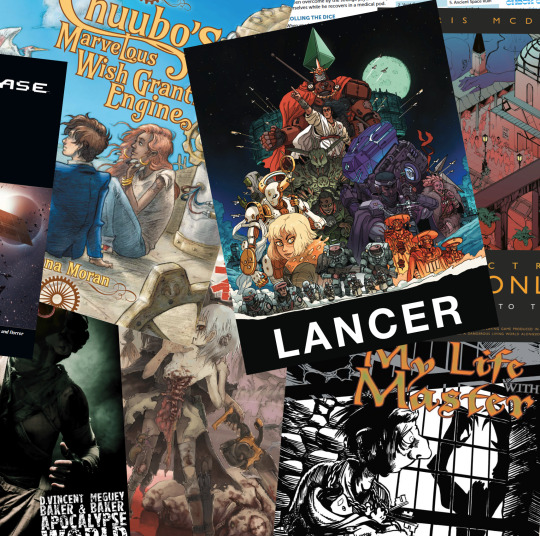
Here's three things I can think of.
This isn't intended as a Forge-like categorisation of games, most RPG books offer (or claim to offer) all of these to some degree, ideally in complementary ways...
A ruling reference - RPG book as legal system
In the intro to a typical mainstream RPG book, this is typically the explanation that is given.
Over the course of a telling a story together, all sorts of weird edge cases come up where you might not want to simply make a call on how it should resolve. Moreover, consistency is valued, for both challenge and narrative reasons.
In this case, the RPG book is a big collection of rulings for specific situations. 'What happens when a character falls off a cliff?' You can look it up. It's like legal precedents. This is how a lot of the stuff in the early D&D books started - stuff that someone had done, and a referee had made a ruling, and it got written down. Then it would get systematised, unified, and streamlined so that it's easier to remember and extend to new situations.
A lighter game avoids special cases and just suggests a general procedure for resolving situations of uncertainty, conflicts etc.
This angle doesn't tend to cover procedures for how the game is physically run - how to go about setting up the scenario, who should get priority when speaking, etc. etc. - beyond perhaps offering prebuilt modules to inspire you. In older games, most of that is stuff you pick up by watching. In newer games... well, hold on.
A grab bag of interesting prompts - RPG book as inspiration in the moment
Most RPG books have flavour text; many also have tables of weird shit you can roll on or select when building a character, character sheets full of interesting abilities, descriptions of NPCs and so on. A select few RPGs like Unknown Armies and Chuubo's Marvellous Wish-Granting Engine have really distinctive prose too.
The aim of all these tools is to give you something to latch onto when you're in the moment and you need to think of the next thing to say. It's also to get people onto some shared understanding of what this game is all about.
This is where the bulk of many RPG books lies. It's explicitly the aim of Apocalypse World's MC moves. Many one-page RPGs are nothing but lists of evocative names and description elements, and a short snatch of prose.
Prompt tables and lists of names are popular in just about every tradition of RPG design - trad, storygames, OSR, all use them. Sometimes they're the most memorable thing about an RPG, like Dark Heresy's crit tables.
Sometimes pages of tables is the RPG - in recent years, card-based games have become popular, using a regular deck of cards which indexes into a big table of events, each of which is like 'here's a short description. how do you respond?'. This type of game has a great deal in common with storylet-based interactive fiction like Fallen London.
Prompts don't have to be short, though. Arguably an adventure module can be pretty much this - something you consult when players arrive in a new place to get an idea of who they should meet for example.
In D&D, the Monster Manual is straight up a book of real freaky guys you can put in your game. It also has stat blocks for them, of course, but the descriptions and pictures do a lot of work here to make them concrete.
This is why I describe the pictures in Lancer as load-bearing. The pictures help - or are supposed to help - grease the wheels of imagination when you're trying to imagine mechs.
This function of RPGs is a large part of the angle you're playing if you tie the game to a particular genre, setting or IP.
A machine to guide you to a specific experience - RPG book as auteur blueprint
So here's the newer flavour.
RPGs can be one of the most feelings-dense forms of art that humans create - it's your story, with your characters. This is something that tends to arise organically after you spend a long time with a character and 'get into their head'.
However, there is often a desire on the designer's side to structure the game to bring about a particular kind of emotional experience more directly. From horror games to games self-consciously 'about' colonialism, abuse, romance, etc., these games try to give you a particular experience, similar to what a film or book gives you - or indeed, a computer game.
Here are some examples:
My Life With Master is an older Forge game. It's about the 'Igor' servant characters in a classic horror movie, billing itself as 'a roleplaying game of villainy, self-loathing, and unrequited love'. It presents you with an emotionally charged scenario and mechanics that try to push you towards specific drama - if you want to be critical, a firm instance of the incentives and buttons oriented design that Huntsman was talking about, sometimes quite explicitly saying 'this mechanic was designed to...'
Dog Eat Dog is a game 'a game of imperialism and assimilation on the Pacific islands', with the DM reimagined as a colonial power adding more and more restrictions and the players as native people who will inevitably break its rules, until they are eventually pushed to 'run amok' (fatally), or assimilate. It's a game whose entire argument is more or less spelled out in the book itself.
But games don't have to be this narrowly scoped to have this kind of aspiration. Something like Apocalypse World still wants to bring about certain kinds of interaction, laid out quite explicitly as 'agendas' for the MC and players. It is strongly 'opinionated', in programmer terms.
Even a very flexible game can take on this model. Fiasco is a very abstract structure, designed to set up a chaotic situation like in a Coen Brothers movie. Microscope is designed to give you a fractal zoom in and out of a fictional history. These games are almost all procedure; Fiasco has some fantastic prompt tables, and a clear way to cook up your own, but the bulk of it is the stuff it tells you to do with scenes and dice.
These could be seen as games on an auteur model, with many of the emotional beats of the scenario already rigged up in advance. You get this type of book to experience a good/meaningful story - with a certain amount of flexibility in the details that gets you more attached. If there is a GM/MC/etc. they have instructions to facilitate the expression of that story.
...well, I refer to it as an auteur model. Thankfully not everyone is Ron Edwards! Apocalypse World has a whole chapter about how to modify the game to your taste, or build new games on its framework, and that - plus its conceptual simplicity - probably played a role in its hundreds of derivatives. 'Hacking' games was well established as a practice in the storygames milieu right from the early days. Probably the vast majority of games put out on itch.io are simply hacks of an established framework, very few offer real innovation.
Despite this, the offer of these products is still that they'll tell you how create a kind of verbal machine to realise some very specific thing.
Secret fourth thing...?
I can't think of others right now, but I hate presenting a list as exhaustive unless I can prove it's exhaustive. It's very likely there's some other function a book can claim to perform.
However, to summarise, you look at an RPG book to get:
a consistent set of rulings to handle situations of uncertainty
a set of prompts to help inspire your imagination when you need inspiration
a carefully designed procedure to lead you to a specific experience
The third thing is kind of a different beast to the other two, huh? You might be thinking that the first two are trad games and the third one is post-Forge 'story games', but it's really much older than that. Paranoia is a great early example; there are shades of it in many games published in the 80s and 90s. Not all these games are affiliated with the Forge and its diaspora either - take for example Jenna Moran's games and Bliss Stage.
Story games are not books either
The Forge and its diaspora led to a lot of games being printed, and launched the careers of many an 'indie TTRPG designer', which was not really a thing you could be in the same way before. It would be easy therefore to think this was the main contribution: we should assess it on the basis of the printed games that resulted.
However, nothing says you have to use a book to pilfer from their idea pool.
The really interesting contribution of the whole movement, to my eye, is that it calls our attention to a facet of TTRPGs that had often been left implicit. Who speaks, when? Who gets the 'narrative authority' to make the final call on what becomes 'true'? How do you organise time - do you frame scenes, use flashbacks, cut between different characters? What makes a dice roll exciting? How do you work out what would engage the other players, and communicate your own interests? Are you trying to help your character win, or are you more like a writer who might choose to make them suffer? How do you make a compelling character arc? What can be changed around behind the scenes to make a better story?
These are all aspects of 'play', the thing that you do at the table. Any given TTRPG group will settle on its own implicit or explicit approach to this kind of thing.
Different RPG books will tell you to do this or that. Some games will tell you to set stakes, or make failure interesting, or make choices that act as 'flags' to show what you're looking for.
But these tools are not tied to any specific game. You don't need the 'permission' of a book, nor can a book stop you doing it. A book may lay out a procedure that makes it easier, may introduce you to an idea that you haven't heard before, but once you have the idea, you can play with it however you like.
The way I approach a trad game like D&D, from either side of the DM screen, has become very different after my sojourn into the world of story games. A lot of what I liked there, I kept doing. Other inspiration comes from outside of the 'hobby' entirely, in related milieu like improv comedy.
This is something the OSR milieu seems to understand quite well. Everything is expected to be mixed, matched, and interpreted by the needs of your group. Posts will be framed as mere advice, which can be picked up and applied regardless of context.
But that all depends on a certain amount of common ground as to 'what the game is'. There is an authoritative DM who runs the scenario. The emphasis of the game is probably on exploring some kind of ruin and surviving in a dark, decaying fantasy world populated by various factions at odds with each other. Players control flimsy characters whose survival is not guaranteed, but if they live long enough, they can become major powers. There is a heavy strategic aspect: you are trying to use your resources to survive and get something. This is the general shape of a 'prototypical OSR game'.
the shared context of storygames
Story games form their own subsubculture, but they do not have this level of shared context. Instead, a different kind of shared context is kind of implicit in the milieu.
Here's how things go at the London Indie RPG Meetup Group, which I've attended a couple of times: a group of nerds gather in a pub. People will pitch games with a couple of sentences; then people will form groups and play that game as a one-shot session. Someone will have a book, or printouts. Most players will not have heard of the game before.
In this kind of context, a lot of the quirks of story games make sense. 'Read this out' paragraphs, rapid character creation based on selecting prompts, simple mechanics designed to push you into drama as quickly as possible: all of this stuff is perfect for a one-shot game you play once or a few times. This type of game is not really trying to 'take on' trad games.
But then there's the 'middle ground' kind of game, which are closer to a 'trad' game - a game master, persistent characters each controlled by one player, multiple sessions, progression - but also instruct you to do something more experimental by trad-game standards. This includes Apocalypse World and its derivatives, Blades in the Dark and its derivatives, the Burning Wheel/Mouse Guard lineage, Jenna Moran's games... and so on.
It's this point of overlap where things get sticky and it all becomes a bit tense. Since, well, story game fans can be quite evangelistic - and part of that evangelism depends on a dismissively book-determinist view of trad TTRPGs. But conversely, trad players can be quite reluctant to imagine there is any other way of approaching this whole activity, and dismissive of any other approach. I do not like it, Sam-I-am.
So you end up with a situation of camps, with both groups bristling at the sense that they should be compelled to give up the thing they like to do it the way they consider inferior.
And if you want to criticise the other camp, what do you do? Pick up their book and criticise it as a product, according to your sense of what a TTRPG book is for. Which seems hopelessly besides the point when a book is such a small part of the story.
I've played trad games, story games, OSR games, 'freeform' forum games, LARP, MMO roleplaying, improv comedy... Not as much as I'd like of anything, but enough to get a sense of the many ways we can do this 'roleplaying' thing, whether by explicit rule or implicit convention.
So the puzzle I now have is, if there is to be a book involved, what is that book there to do? What really makes for a good RPG book? Are there other ways to get that thing? How do you game design honestly?
We'll try to address that in part 3 of this series, coming... sometime soon, hopefully!
22 notes
·
View notes
Text

Here's a Scooby-Doo card game I picked up off Facebook Marketplace. I've played it a couple times and it's really fun! I'll give you a tour of the pieces, how to play, and some of this game's quirks that I've noticed. (Notice the textured metal cover -- so cool!)

The game contains an instruction card, 14 large Group Photo cards, 4 plastic card stands, 72 playing cards, and a score pad and pencil.
Each player gets their own Group Photo which shows 6 characters arranged in front of a background from the TV show. Here I've sorted them by background.

You can tell that a lot of creativity and thought put into these arrangements. Characters will interact with each other, strike unique poses, and hide behind each other or pieces of the background, which I can't imagine was easy to edit in 2003 when this game was made. Here are some of my favorite Group Photos:





It's also in these photos that we see the first few of this game's quirks:
In the first photo, Captain Cutler lacks color.
In the photo with Velma searching for her glasses, the Wolf Man has a black nose, but in the photo with Shaggy scared in the foreground, the Wolf Man's nose is uncolored. I would guess that when they were designing these photos, the designers were pulling from a digital library of character art; when the scans of the characters were being uploaded to digital, one of the artists missed a glance at the reference sheet. And they thought I wouldn't notice!
Some crazy size inconsistencies: see how tiny the alien is next to Redbeard, and how huge the Zombie is next to the Wolf Man!
My favorite card is definitely the last one, with Velma shushing Scooby while 4 monsters are approaching behind. I haven't seen this official art of Velma, it's very cute! I think the movement lines are fun.
Now, to the gameplay!
The object of the game is to get the 6 cards in your hand to match the 6 characters in your Group Photo. You do this by drawing and discarding 1 card every turn. Here's an example of a winning hand that has Daphne, the Creeper, the Witch Doctor, Scooby, and two Wild Cards.

There are 3 types of playing cards: Character Cards, Photo ID Cards, and Wild Cards. The winning hand above happens to have 2 of each type of card. Character Cards show an zoomed-in picture of a character; these are the most common card. Photo ID cards have captions in blue and are harder to find. You need at least two Photo ID cards in your hand to win the game (unless you have a certain Wild Card -- more on that later).

To collect all 6 of your characters quickly and to slow down your opponents, the Wild Cards will be very helpful. There are 4 types of Wild Cards that all have different functions:
Camera Shy can be used in place of a character card.
Say Cheese can be used in place of a character card, and also counts for one of the 2 Photo ID cards you need to win the game.
Red Eye lets you search the discard pile and draw any card. It also reverses the direction of play.
Overexposed can be used to switch out your Group Photo card for another one, or to force another player to switch out their Group Photo card! (If you save this card for late game, you can make enemies fast.)




When a player has gathered a winning hand, they lay down their cards and say "Frame it!" All players earn points based on who finished first, the types of cards in their hand, and how well they match their Group Photo card.
Winner bonus +6
Photo ID card matching Group Photo +2
Say Cheese card +2
Character card matching Group Photo +1
Camera Shy card +1
Photo ID and Character cards not in your Group Photo +0
Red Eye card -2
Overexposed card -2


Here is the winning hand I showed before. If this player finished first, the winning hand on the left would be worth 15 points (1+1+2+2+1+2+6). However, if you are strategic, you may wait to lay down your hand and try to replace your Character Cards for Photo ID cards, and any Camera Shy cards for Say Cheese. The hand on the right, which shows the same characters as the left but with more valuable cards, would be worth 18 points (2+2+2+2+2+2+6). It doesn't seem like much of a difference, but if you play over multiple rounds, 1 point can mean everything! (I would know -- in my last game, I lost by just 1 point!)
Overall, "Scooby-Doo: Group Photo" is a fun game. It can start to drag if players are drawing unlucky, but the rules are simple enough that players could make home modifications without too many complications. This is one of those games that's hard to explain but easy to pick up and quick to master.
Now that the gameplay is done...
More card art!
Here are the Photo ID cards for all the members of the gang. Some fun details:
Shaggy's caption describes him as being reliant on Scooby, but Scooby's caption makes no mention of Shaggy and only mentions his love of Scooby Snacks. Wowwww.
Daphne wants to write for a detective magazine in the future (little does she know, she's going to have her own talk show!).
They really did Velma dirty with her photo. Justice for Velma :(





And here are some Photo ID cards I thought were interesting:
The inclusion of one of the aliens from Alien Invaders (2003) among all of these original series villains (1969-1970) is an interesting choice... That movie came out 3 years before this game did, so maybe it was for promotional reasons?
Regarding the Alien's caption, I don't remember it being part machine...
I sincerely don't know where this mummy is from. It's not the "Coin, coin!" mummy, I can tell you that much.
The inclusion of the Mystery Machine as a character. This was ultimately a good choice, I think, because it really livens up the composition in the group photos.
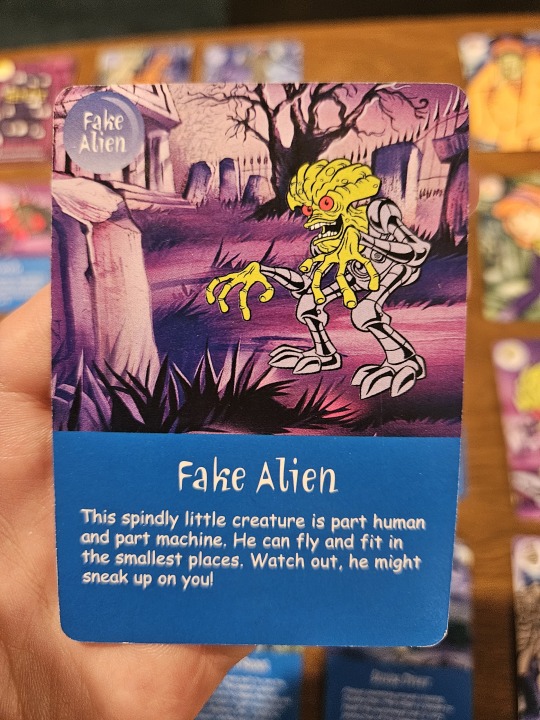


Another recurring quirk: missing eyebrows on Character Cards!


For more info on the game, here's the official rule card:


11 notes
·
View notes
Text
Greetings, Dirk Gently fandom; I bring you great news! A saviour has been born!
Introducing: a searchable DGHDA scene index!
-
What is it?
It's a way to categorise and search for every single scene in the show.
You can sort by character, tone, season, activity level, etc, and the spreadsheet will automatically give you all the scenes that match your search with a link to their start and end times on YouTube!
Why?
The original intention of this was for fic writers – as the writing equivalent of a folder of reference images. But it has as many applications as you can think of for it!
How?
Four days of me hyperfocusing on spreadsheet formulae. Worth it.
-
But!!! There's a Problem!
See, I've set the whole thing up, with formatting and formulae and so on – but, at present, there isn't actually anything in it.
There's something like 900 scenes in the whole show.
So: I'm asking for your help!
I've got a document linked below explaining everything involved, but in short: if we produce a community effort and divide the episodes between us, the whole thing will be filled out and functional much more quickly!
There's no pressure to do anything you don't feel up for, so don't feel like you have to input loads to take part! And if you don't take part at all for any reason, that's also completely fine. Your presence in the fandom is always enough <3
If you do feel up for anything, your help will be greatly appreciated!!
Interested? Read the document and get in touch!!
The Guide Document:
The Spreadsheet:
(The sheet is view-only at the moment for safety. Read the document and get in touch with me if you'd like to help out!)
-
P.S. We've got an active DGHDA discord server if you'd like to hang out and discuss anything DGHDA related! The guys there have been vital to this spreadsheet's production so far, and are wonderful to be around; come join us if you want to! Here's the link - DM me somewhere if it's expired!
#dghda#dirk gently's holistic detective agency#fanfic related#dghda fic#writing resources#tw big text#tw bold text#'There isn't actually anything in it' is now not technically true because we've got some wonderful people inputting already!!#but you get the gist#also sorry about the biblical wording at the top
79 notes
·
View notes
Text
How to Conduct a Literature Review Using Digital Tools (with Notion Template)

Embarking on a literature review is a fundamental component of academic research that can often appear overwhelming due to the sheer volume of relevant articles and sources. However, leveraging digital tools like Notion can substantially streamline and enhance this process. By providing a structured approach, Notion enables researchers to manage their literature reviews with greater efficiency and organization. This comprehensive guide will walk you through a methodical literature review workflow using Notion, explore various digital tools, and offer a Notion template to facilitate your research.
The Benefits of Using Notion

Notion is an advanced organizational tool that integrates the functionalities of note-taking, project management, and database creation into a single platform. Its versatility is particularly advantageous for managing a literature review. Here are several key benefits of using Notion:
Integration of Pages and Databases: Notion allows for seamless linking of pages and embedding of databases within other pages. This interconnected structure facilitates comprehensive data management and easy navigation between related information.
Customizable Filters and Sorting: Users can create custom properties and apply filters to databases, which enables sophisticated sorting and retrieval of data tailored to specific research needs.
Efficient Data Management: Notion supports the transfer and management of data from Excel sheets, enhancing the organization and accessibility of research materials.
In my workflow, Notion plays a central role through two primary databases: the ‘literature tracker’ and the ‘literature notes’ matrix. These databases are instrumental in tracking papers and synthesizing information to construct a coherent argument.
Stages to Literature Review Workflow
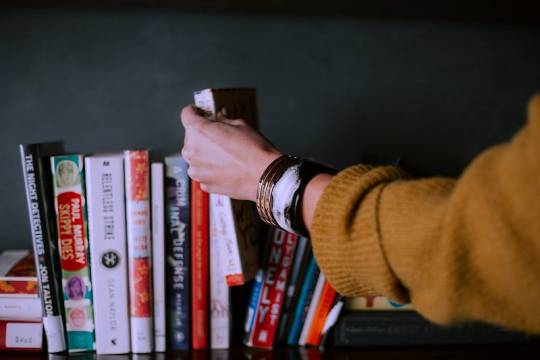
1. The Literature Search
The initial phase of a literature review involves a systematic search for relevant sources. This step is critical for building a comprehensive and well-rounded review.
Identify Keywords: Begin by developing a list of keywords that are pertinent to your research questions. Engage with your supervisor or colleagues to refine this list, ensuring it encompasses all relevant terms. As you progress, be prepared to adjust your keywords based on emerging research trends and findings.
Utilize Database Search Tools: Employ established databases such as Web of Science, Scopus, Google Scholar to locate pertinent literature. These platforms offer extensive search functionalities and access to a broad range of academic papers. Additionally, set up email alerts for new publications related to your keywords. This proactive approach ensures that you remain informed about the latest developments in your field.
Library Building and Recommendations: Manage your literature library using tools like Mendeley, which facilitates the organization of references and offers recommendations for related papers. Mendeley’s sharing capabilities also enable collaboration with colleagues, enhancing the collective management of research resources.
2. Literature Mapping Tools

Literature mapping tools are invaluable for visualizing the relationships between papers and identifying key research themes.
Citation Gecko: This tool constructs a citation tree from ‘seed papers,’ illustrating the connections between various studies through their citation relationships. It is particularly useful for uncovering seminal works and understanding the progression of research topics.
Connected Papers: Connected Papers uses a similarity algorithm to generate a graph of related papers based on a given key paper. This tool provides insights into related research that may not be immediately evident through direct citation links, helping to broaden your understanding of the field.
3. The Literature Tracker
An organized literature tracker is essential for managing and reviewing research papers effectively.
Organize with Notion: Utilize Notion’s customizable properties to document essential details of each paper. This includes metadata such as title, author, publication date, keywords, and summary. The ability to filter and sort this data simplifies the process of managing large volumes of literature.
Database Views: Notion offers various database views, such as the kanban board, which can be used to track your reading workflow. This visual representation aids in monitoring your progress and managing tasks associated with your literature review.
4. The Literature Synthesis Matrix
The synthesis matrix is a crucial component for organizing and synthesizing information from the literature.
Second Pass of Papers: After an initial screening, populate the ‘literature notes’ database with detailed information from the papers you deem relevant. This should include comprehensive notes on the paper’s summary, key results, methodology, critiques, and any future work suggested.
Relational Databases: Leverage Notion’s relational database capabilities to link related papers and create a synthesis matrix. This matrix helps in identifying connections between different studies and assists in constructing a coherent narrative for your literature review.
5. Writing Your Literature Review

Writing a literature review involves synthesizing the collected information into a structured and insightful analysis.
Identify Research Themes: Use your literature matrix to pinpoint key research themes and questions. These themes will form the basis of your literature review sections and guide the development of your thesis statement(s).
Summarize and Evaluate Sources: Focus on the most significant sources for each theme, summarizing their key points and critically evaluating their contributions. This involves assessing the strengths and weaknesses of each study and linking related research to provide a comprehensive overview.
Situate Your Research: Clearly articulate the research gap your study addresses, justifying your research approach based on the identified gaps and the synthesis of the reviewed literature.
6. Iterating Your Literature Review
A literature review is a dynamic process that requires regular updates and revisions.
Regular Updates: Continuously update your literature review as new research emerges. Balance the time spent on reading with the progress of your own research to ensure that your review remains current and relevant.
Notion Template
To facilitate your literature review process, I have developed a Notion template that includes:
A Literature Tracker Database: For recording and managing details of relevant papers.
A Literature Notes Database: For detailed notes and synthesis of the literature.
Predefined Properties: For filtering and sorting entries according to specific research needs.
You can duplicate and customize this template to fit your research requirements.
Useful Resources
Here are some additional resources that can aid in the literature review process:
The Literature Review: Step-by-Step Guide for Students
3 Steps to Save You From Drowning in Your Literature Review
How to Write a Literature Review
How to Become a Literature Searching Ninja
Mind the Gap
7 Secrets to Write a PhD Literature Review The Right Way
By following this structured approach and utilizing digital tools like Notion, you can streamline your literature review process, enhance organization, and ensure that your research is thorough and well-founded. This methodology not only simplifies the review process but also provides a robust framework for developing a strong thesis or dissertation.
Investing in your academic future with Dissertation Writing Help For Students means choosing a dedicated professional who understands the complexities of dissertation writing and is committed to your success. With a comprehensive range of services, personalized attention, and a proven track record of helping students achieve their academic goals, I am here to support you at every stage of your dissertation journey.
Feel free to reach out to me at [email protected] to commence a collaborative endeavor towards scholarly excellence. Whether you seek guidance in crafting a compelling research proposal, require comprehensive editing to refine your dissertation, or need support in conducting a thorough literature review, I am here to facilitate your journey towards academic success. and discuss how I can assist you in realizing your academic aspirations.
#gradblr#academics#education#grad school#phd#phd life#phd research#phd student#phdblr#study#studyspo#students#studyblr#studying#student#study motivation#study blog#university student#uniblr#university#dissertation help#dissertation writing#dissertation abstract#dissertation topics#phdjourney#graduate school#thesis writing#thesis help#thesis tag#thesis statement
6 notes
·
View notes
Text
A Real-Life Barefoot Contessa

Well, what can I say. She's fabulous.
The Fabulous She I refer to above is the Contessa di Castiglione, who, were she living today, would be making millions on Instagram, TikTok, YouTube, and a gazillion other social media platforms. Being that she lived during the 19th century (1837-99), the Contessa had to settle for the reproductive mass media tool of her time—Photography. It was a medium with which she became familiar and whose function, beyond that of utility, she grasped profoundly. But not as a mere recorder of reality. No, for her it was an instrument of fantasy: Of role-play and the projection of a kind of imaginative truth—the truth of the Inner Self. That Being we see not in the mirror or in the eyes of others, but in our minds. The Self not known to mundane existence but as the most personal, intimate, and rarefied form of Art.
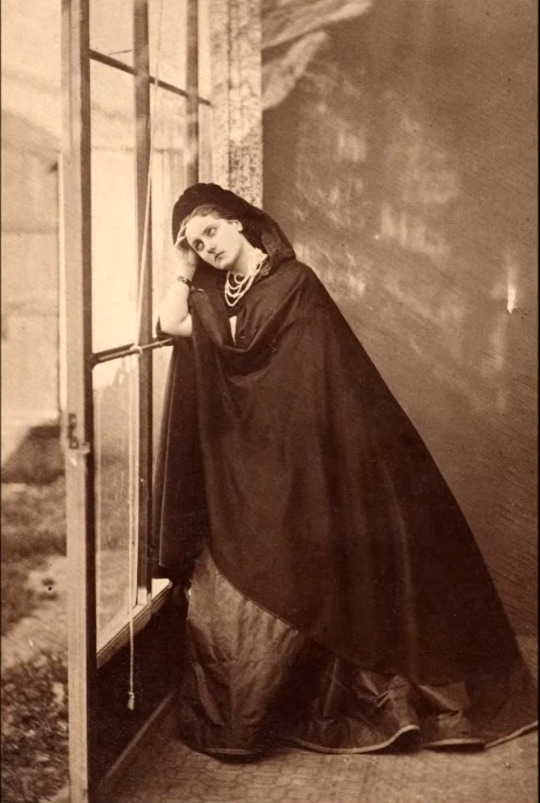
Over the course of some thirty-odd years, the Contessa had about 700 photographs taken of herself, in all sorts of costumes, in all sorts of poses, in all sorts of moods. She would wear her most extravagant gowns, she would stage herself in tableaux taken from history, theater, literature, and from her own life; she would present her bodily parts (mainly bare feet and legs) as brazenly fetishized objects; and she would frequently be seen gazing—at the camera, towards the distance, and at herself, reflected in hand mirrors and pier glasses. She fashioned herself as a self-image within another self-image, a self-referential, self-knowing portrait of who and what she was—a creator of herself as an Object of Art.
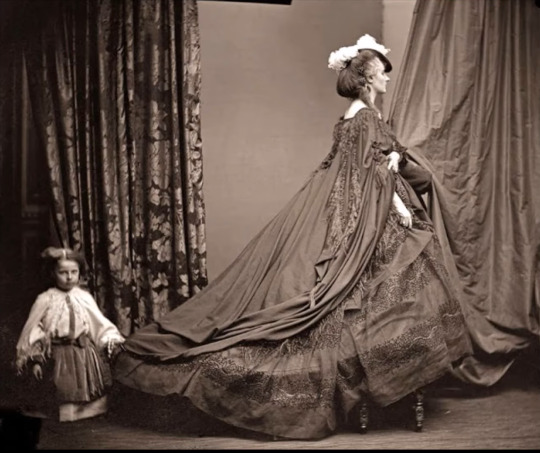


Our Contessa did have an interesting, pre-photography history. Born Virginia Oldoini Rapallini to minor Italian nobility, she was wedded, not of her choice, at age 17 to the some-12-years-older Count Castiglione, a union that produced one son and much unhappiness for an ill-matched pair. But when, at the urging of a diplomatic cousin, the Contessa arrived, in 1856, at the court of Emperor Napoleon III, to argue for the cause of Italian unification, she came into her own. Beautiful (extremely), witty, willful, and daring, the Contessa quickly slipped between the Emperor's sheets, while titillating the French aristocracy with her flamboyance, her outrageous fashions, and, even then, her complete self-absorption. You could call her the Kardashian of her time, except the Contessa was (and is) way too cool; no vulgar Kardash of today has one tittle of the Contessa's elegance, style, taste, and her utter sense of being—Fabulous.

Such Fabulousness, however, then as now, had a price. In a matter of months, the Contessa's affair with the emperor had fizzled, her husband had separated from her, and various scandals (mainly to do with her dramatic costuming, or presumed lack thereof) sent her packing from the Court. Within a few years, she had retired to a solitary anonymity in the Parisian suburbs. Although she continued to correspond with influential friends and lovers, she was soon forgotten by a world she had once dazzled.
But it was then she began her real vocation: To have herself—her life, career, legend, her imagined Being—inscribed in the most sophisticated recording medium of her era. With her reproduced images being sent to family, lovers, and friends, it was thus the myth of the Contessa was born—leaving to posterity, in nearly 700 photographic images, her tribute to the Self, a paean to Narcissism, as complete, obsessive, and solipsistic a voyage of Self-Creation as can be imagined. For which we can all be grateful.
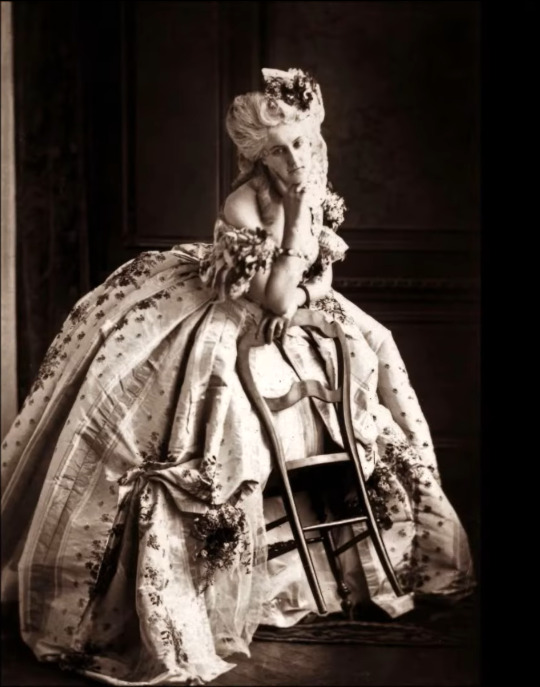
Even when the lady had passed on, to that great photographic studio in the sky, recording media was still obsessed with the Contessa. The 20th century has taken advantage of her legend and allure to construct several films around her life, two of which I have seen. Both these films—La Contessa Castiglione of 1942, and The Contessa's Secret (also known as La Contessa di Castiglione) of 1954—follow her pre-photographic activities at the French court and her relationship with Napoleon III, while also touching on the cause of Italian unification (the putative reason for her Imperial seduction). Not that the Contessa lacks for other company; in each film a dashing young beau makes sure she's never at a loss during her down times. Another kind of Unification comes to the fore here.

I can't say how accurate either film is about history or biography, as each one (made in Europe) is dubbed in non-subtitled Italian, a language I don't know. I suspect, however, that for each History is merely an armature, a tailor's dummy (almost literally) to display the Contessa's stunning costumes, hair styles, jewelry, and fabled beauty. What the films lack in concrete Risorgiomento history is more than made up in their imaginative recreations of Risorgiomento fashions, style, and manners, an emphasis filtered, I sense, through a box-office consciousness of where audience interest will lie.

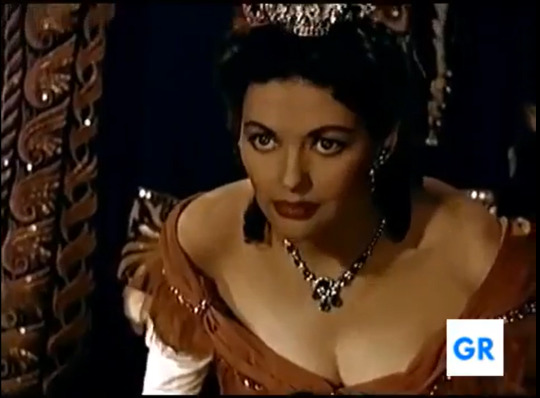
Such interest is foregrounded in the two actresses who portray the Contessa—Doris Duranti in 1942, Yvonne de Carlo in 1954. Both are amazingly beautiful women (which, no doubt, would have pleased the real Contessa), yet each one in her film is different in her look, performance, and image. They're almost reverse copies of each other: The slender Duranti is as pale as a Wili, with the delicacy of antique lace and the brittleness of an embroidery needle; whereas the fleshy de Carlo is dark, round, and energetic, an endearing touch of middle-classness in her style. The performances may not be the same, yet each one individually satisfies a fantasy of High Romance: If Duranti is a drooping lily, too frail and exquisite for everyday mucking-about, de Carlo is fiery, eager, sincere, an American-Canadian housewife's ideal of aristocratic passion, adventure, and glamour.

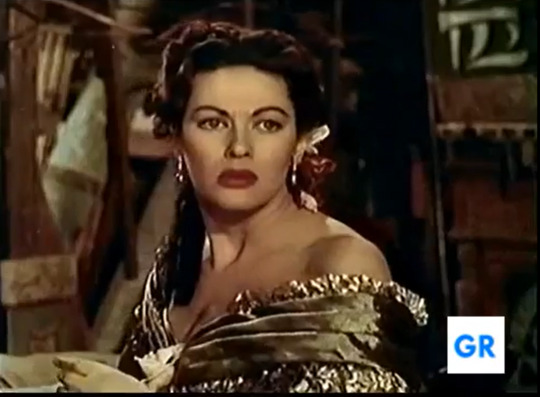
Is either portrayal anywhere like the real Contessa? I suspect not. Each performance arises from a 20th-century notion of Romance as portrayed in the Woman's Film genre—in which Life is a serial melodrama, a self-absorbed Theater of Emotion enacting scenes of Love, Passion, Despair, Renunciation, and Transcendence. Neither film touches on the Contessa's later career as a self-acting photographic model, yet curiously, each film does refer to Acting. In the 1942 film the Contessa is seen posing in what look like tableaux staged for the amusement of the French court; in the 1954 version she's seen attending elaborate theatrical performances. Artifice, as well as Art, is never far from the glittering boundaries of the Contessa's imaged self.
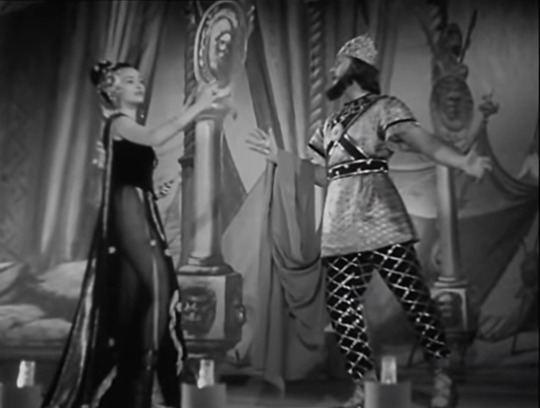
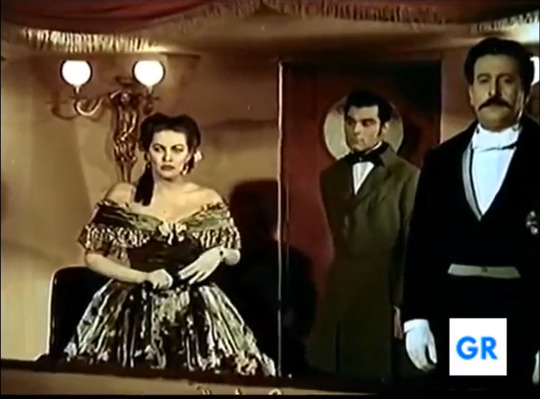
I'm guessing such scenes were inserted as commentary on the dramatic situations within each film. Yet, from another perspective, they can also be (foreshadowing) critiques of the Contessa's later photographic obsession, in which she depicted herself in scenes of what can be called a private Theater of the Mind: Portraying herself as gay, solemn, seductive, pensive, flirtatious, and, perhaps most alluringly—as detached; a distant object whose cool, blank gaze at the camera (and spectator) seduces us by its very remoteness. Gazing ourselves at these self-acted scenes, we might ask—how much of what we see is the actual Contessa, and how much is what we project onto her? Is the Contessa acting out self-fantasies for her own secret pleasure? Or is she 'acting,' as did Duranti and de Carlo, for a possible public, to view and witness her images, which become in turn embedded in our own fantasies of who this fabulous being is?

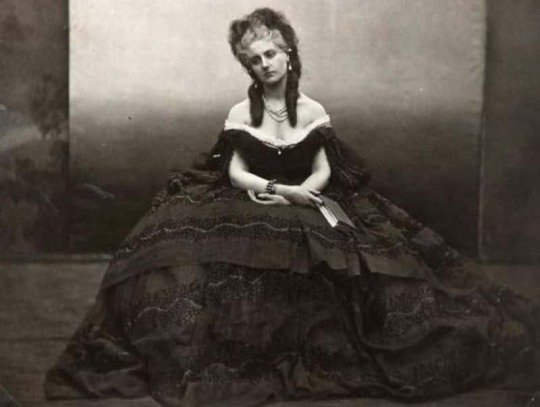

I've no doubt were she alive today, the Contessa would be making videos of herself on YouTube, home movies, as it were; creating, once again, a self-image for her admirers, aided by the marvelous additions of motion, color, and sound. What would they look like? What facets of this complex, complicated personality would be on view? Would they be bold, opinionated, spontaneous? Would she be commenting on current events, or indulging in gossip, or handing out beauty tips for self-improvement of the masses? Or would they be like her photos—silent, mysterious, teasing, contemplative, self-absorbed; indeed, self-enchanted with her changing, changeable, yet somehow always unchanging Self? We can only fantasize ourselves as to what they would be. As well as to what we would, within our own minds—see.

You can view more photographic images of the Contessa here. I've also written more on the Contessa di Castiglione, and the two films on her life, here at my Grand Old Movies blog. Because someone so Fabulous deserves to be written more about.
#Contessa di Castiglione#black and white photography#photography#19th century#Risorgiomento#Napoleon III#melodrama#woman's film#history#2nd Thoughts#self portrait#self love
6 notes
·
View notes